Introduction
Visiting Topkapi Palace is less like ticking off a major historical site and more like slipping through a threshold into another world—one that thrums with centuries of ceremony, secrecy, and immense imperial scale. More than just a museum, it’s a walled city of domed pavilions, lush courtyards, quiet libraries, ornate fountains, and storied relics. You could easily spend an entire day here (and we recommend that you do).
To save time and skip the long entrance queues—especially during high season—we suggest getting skip-the-line tickets. You’ll want every extra minute to wander freely, follow your curiosity, and make room for wonder.
A palace built on transformation
Perched on the tip of the historic peninsula, with views stretching over the Golden Horn and Bosphorus, Topkapi Palace was commissioned by Mehmed the Conqueror in the late 15th century, shortly after the Ottoman conquest of Constantinople. What began as a relatively modest court grew into a sprawling, labyrinthine complex, continuously expanded and renovated by successive sultans until the 19th century.
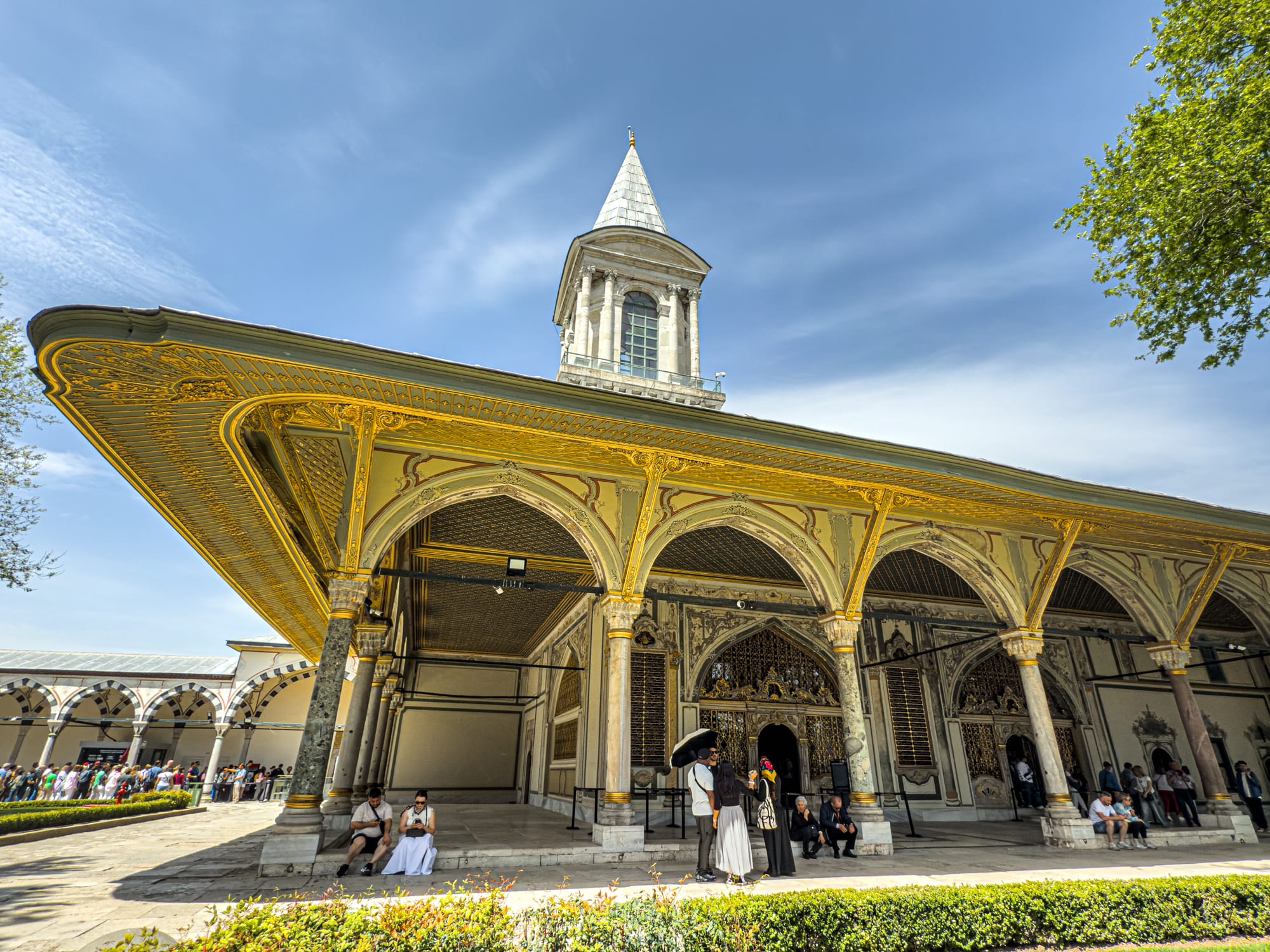
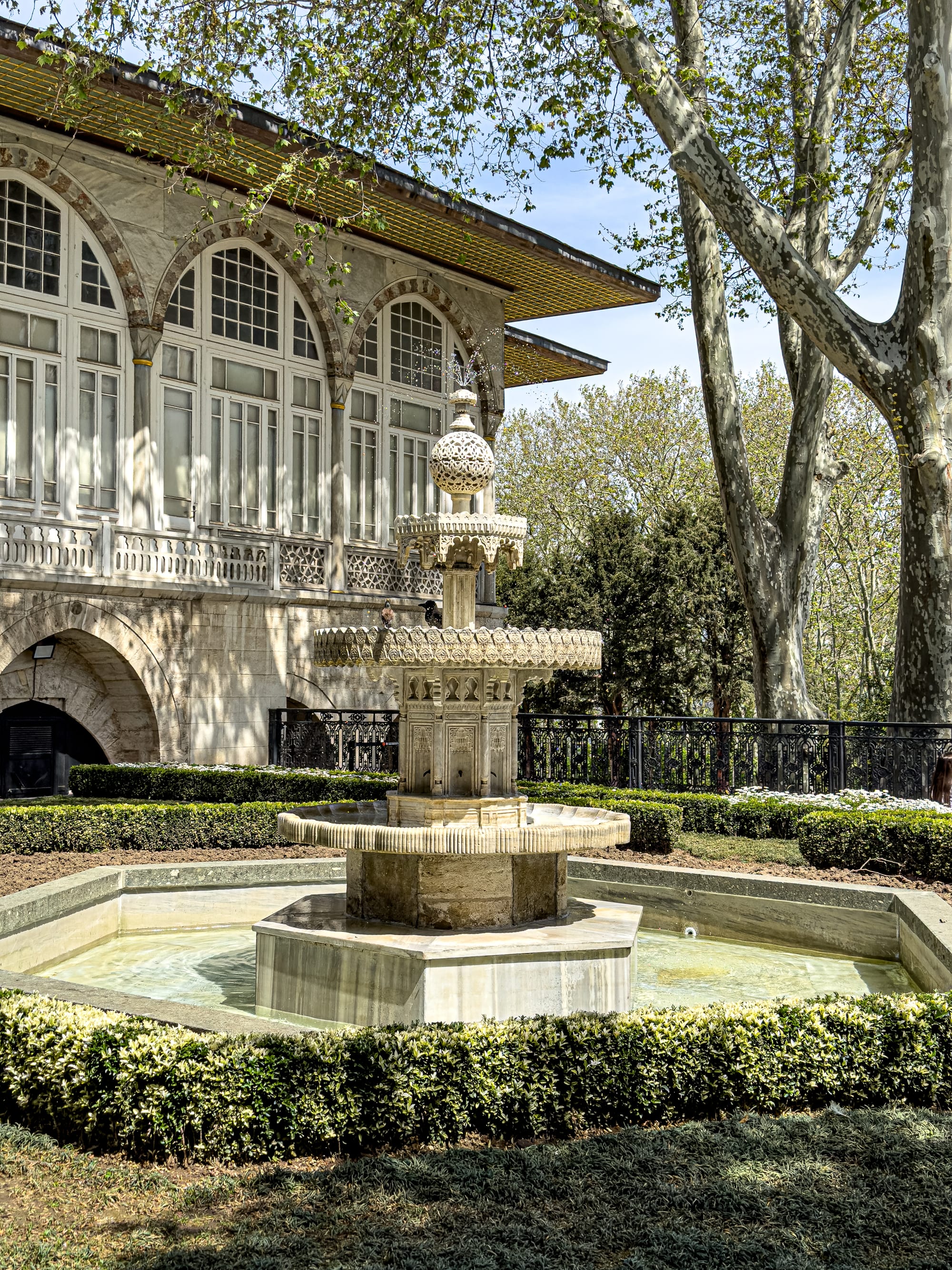
Topkapi Palace’s ornate pavilion and fountain garden reflect Ottoman luxury and imperial serenity
It functioned not only as the royal residence but also as the administrative and ceremonial heart of the Ottoman Empire for nearly four centuries. Sultans ruled from here. Major state decisions were made here. The Harem, the Divan, the Treasury, the kitchens—every wing played a role in sustaining the imperial world.
Yet Topkapi never quite fits the symmetry or austerity one might associate with European palaces. Instead, it reflects a more fluid and incremental logic: buildings added on over time, open courtyards giving way to intricately tiled chambers, views onto tulip gardens and domes layered with geometry, gold, and deep sky blues. It is a place of thresholds, transitions, veils.
The outer courtyards and palace grounds
Many visitors enter Topkapi through the Imperial Gate, leading into the First Courtyard—a large open green space that once functioned as the service grounds of the palace. You’ll pass ancient cypress trees, paths lined with flowers, and remnants of older structures. It’s one of the few places in the palace where you can breathe in expansive quiet.
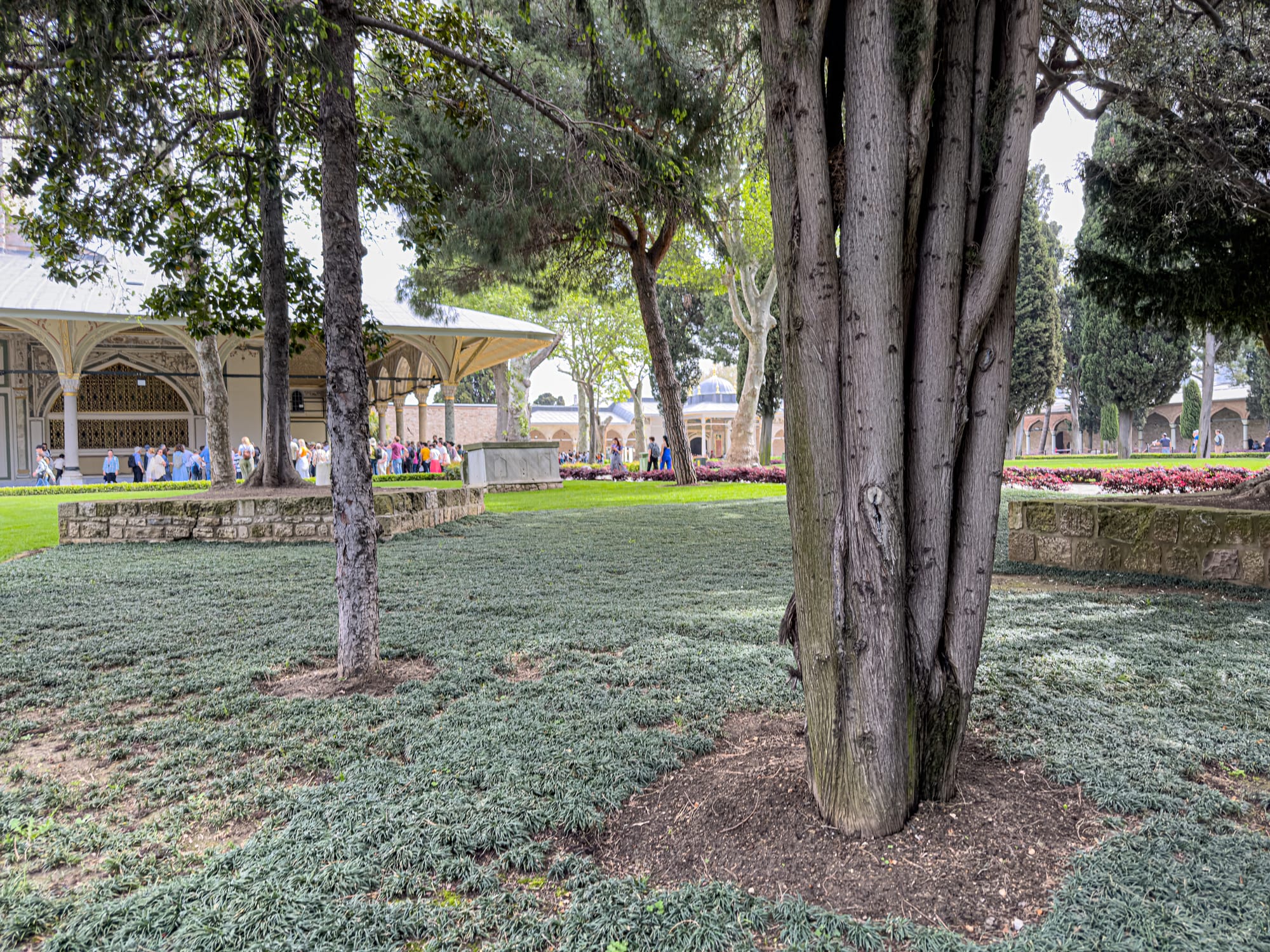
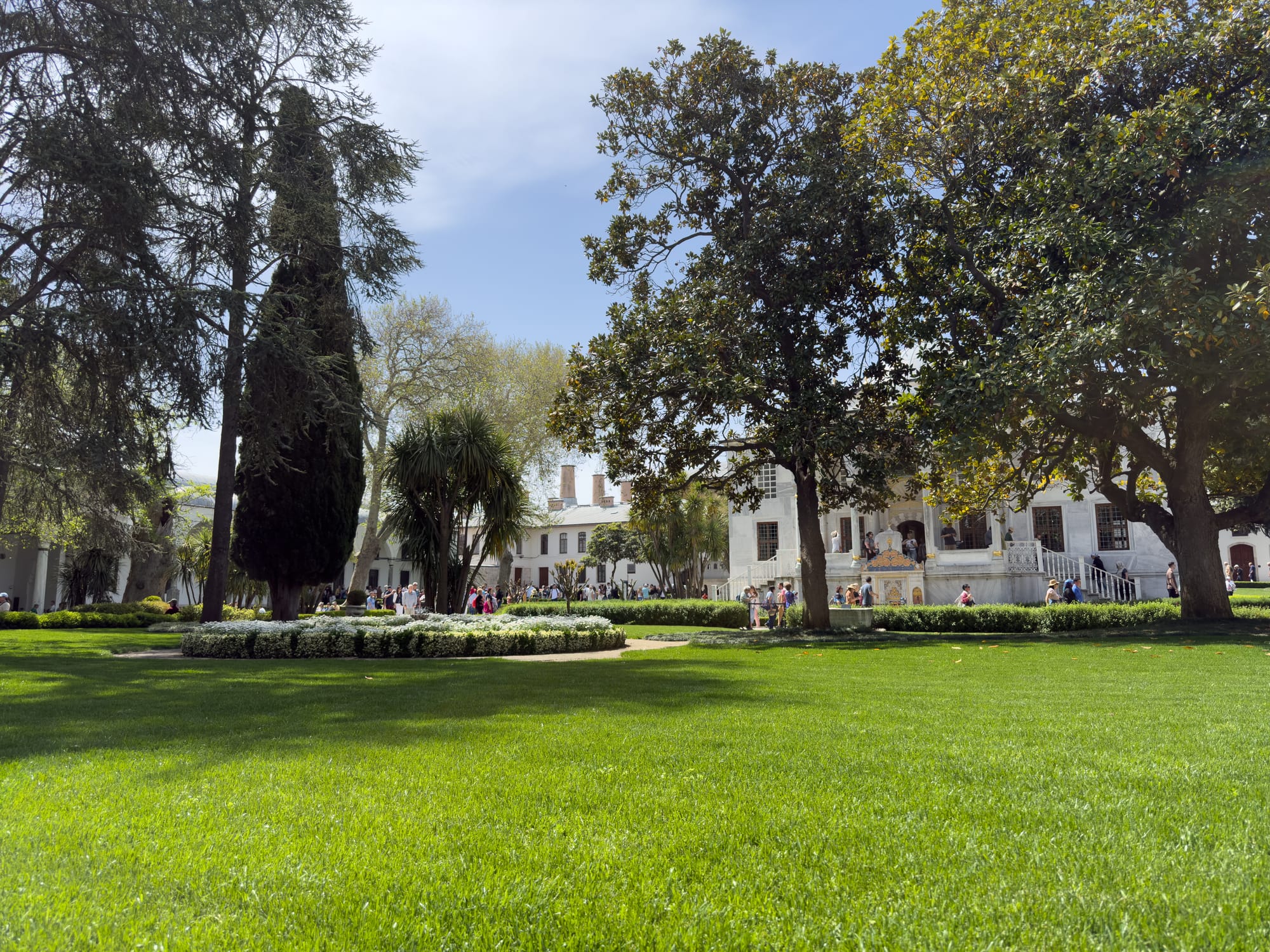
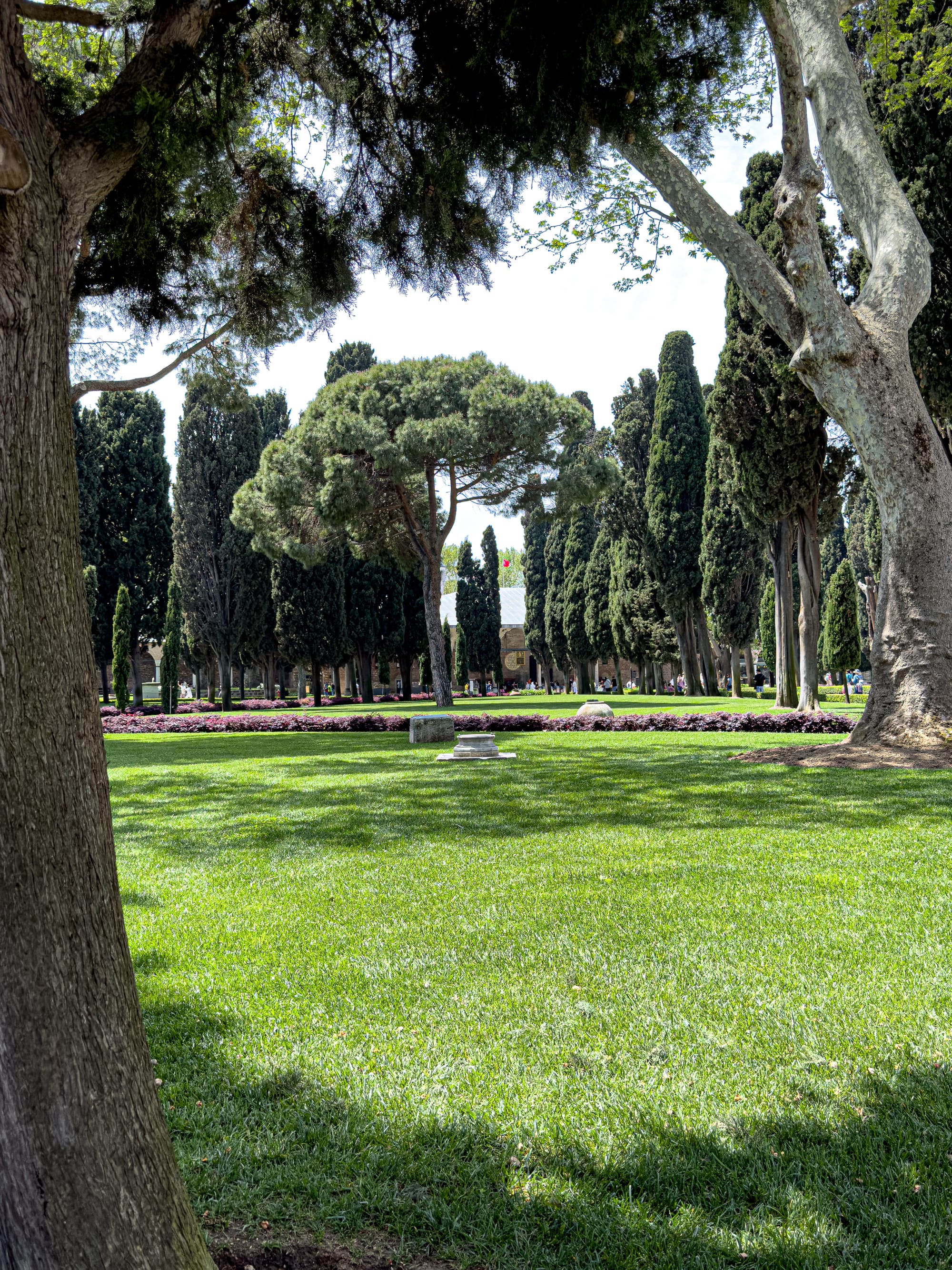
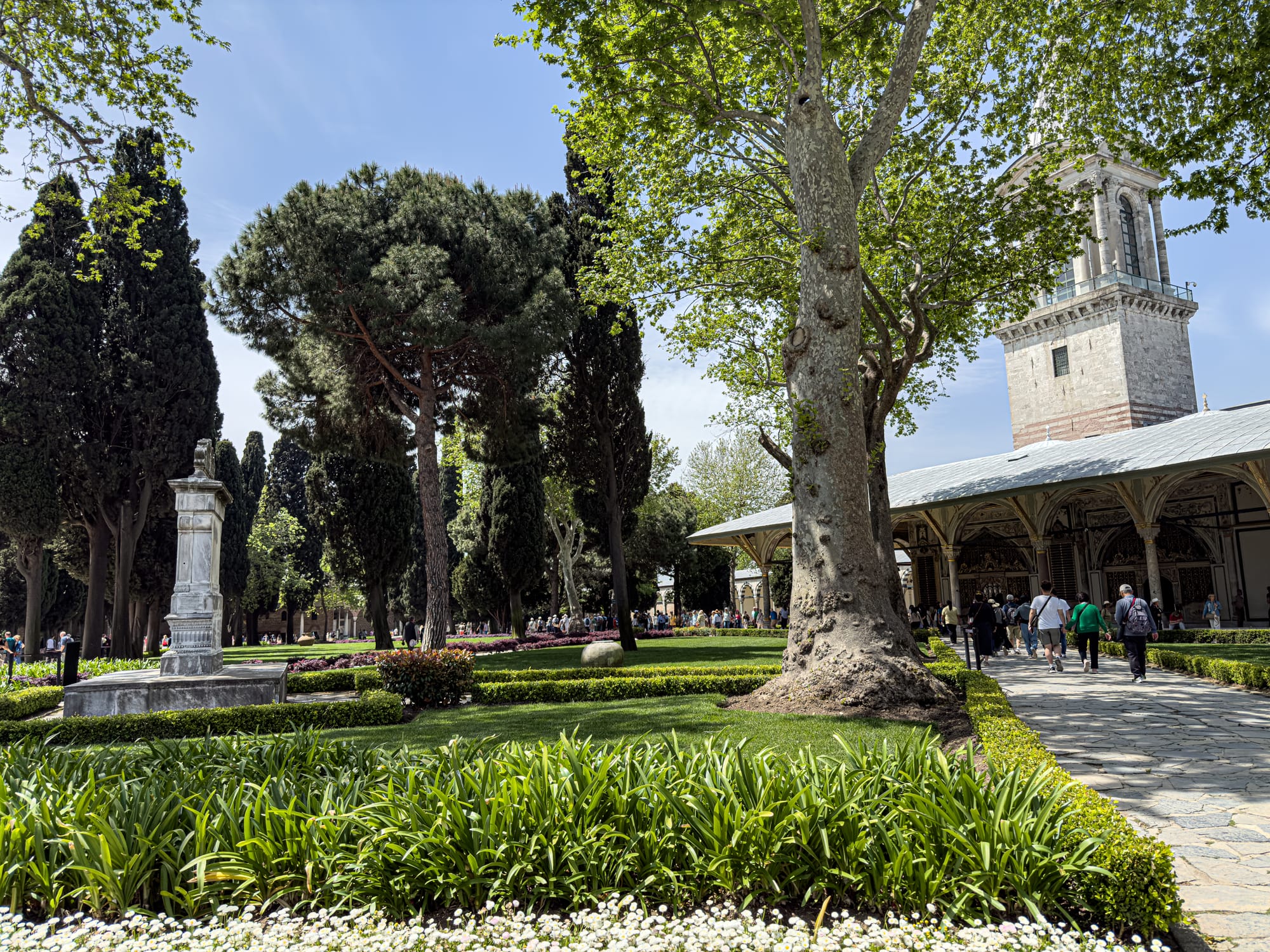
Lush gardens and towering trees offer a peaceful pause within Topkapi Palace’s imperial grounds
From here, you’ll enter the Second Courtyard through the Gate of Salutation, marked by twin towers. This is where the real gravity begins: on one side, the massive imperial kitchens (now housing collections of porcelain); on the other, the Council Hall (Divan), where viziers convened under a domed ceiling to deliberate state affairs. The layered ceilings, chandeliers, and ornamented exteriors speak to the theater of bureaucracy and ritual.
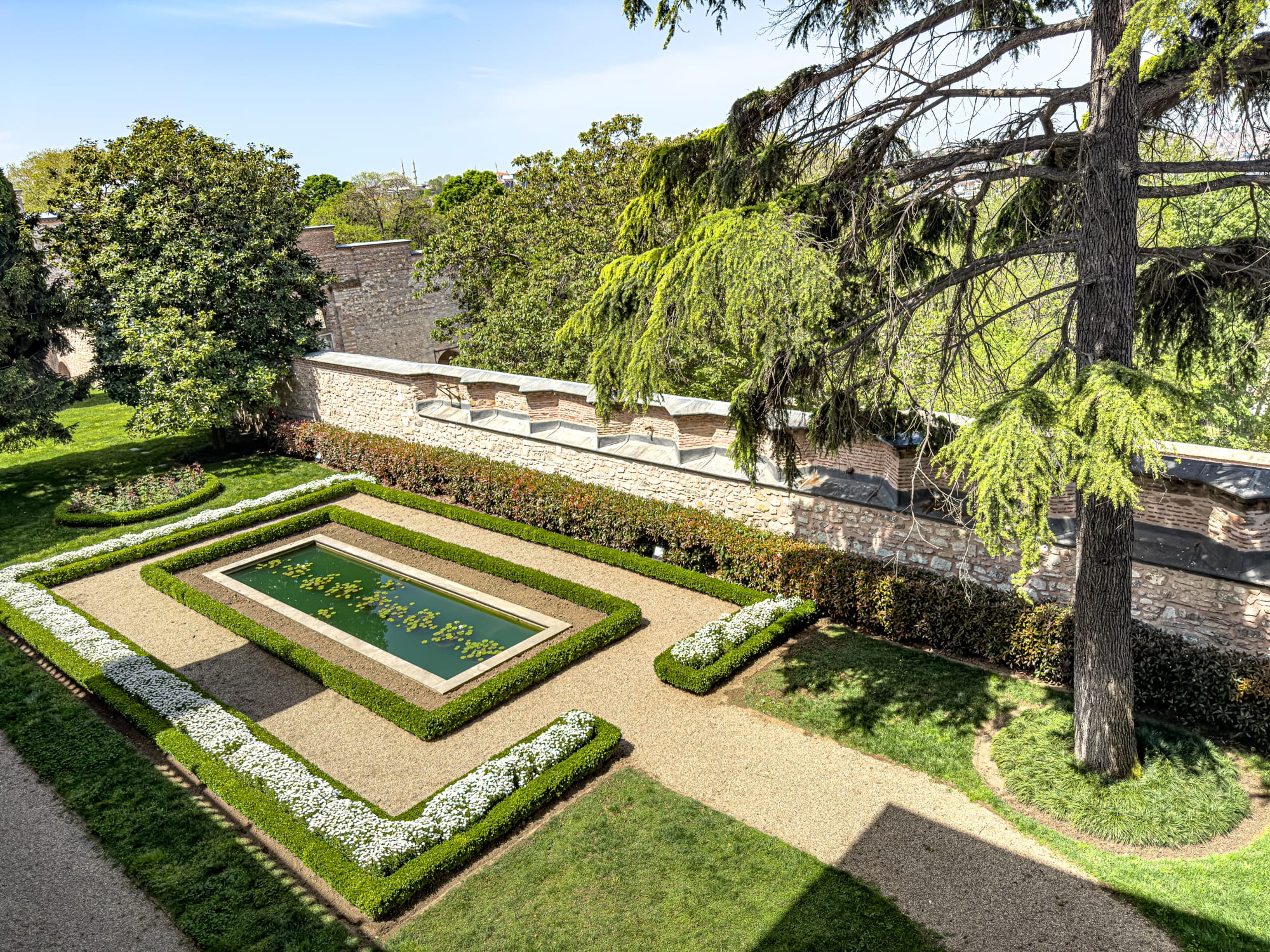
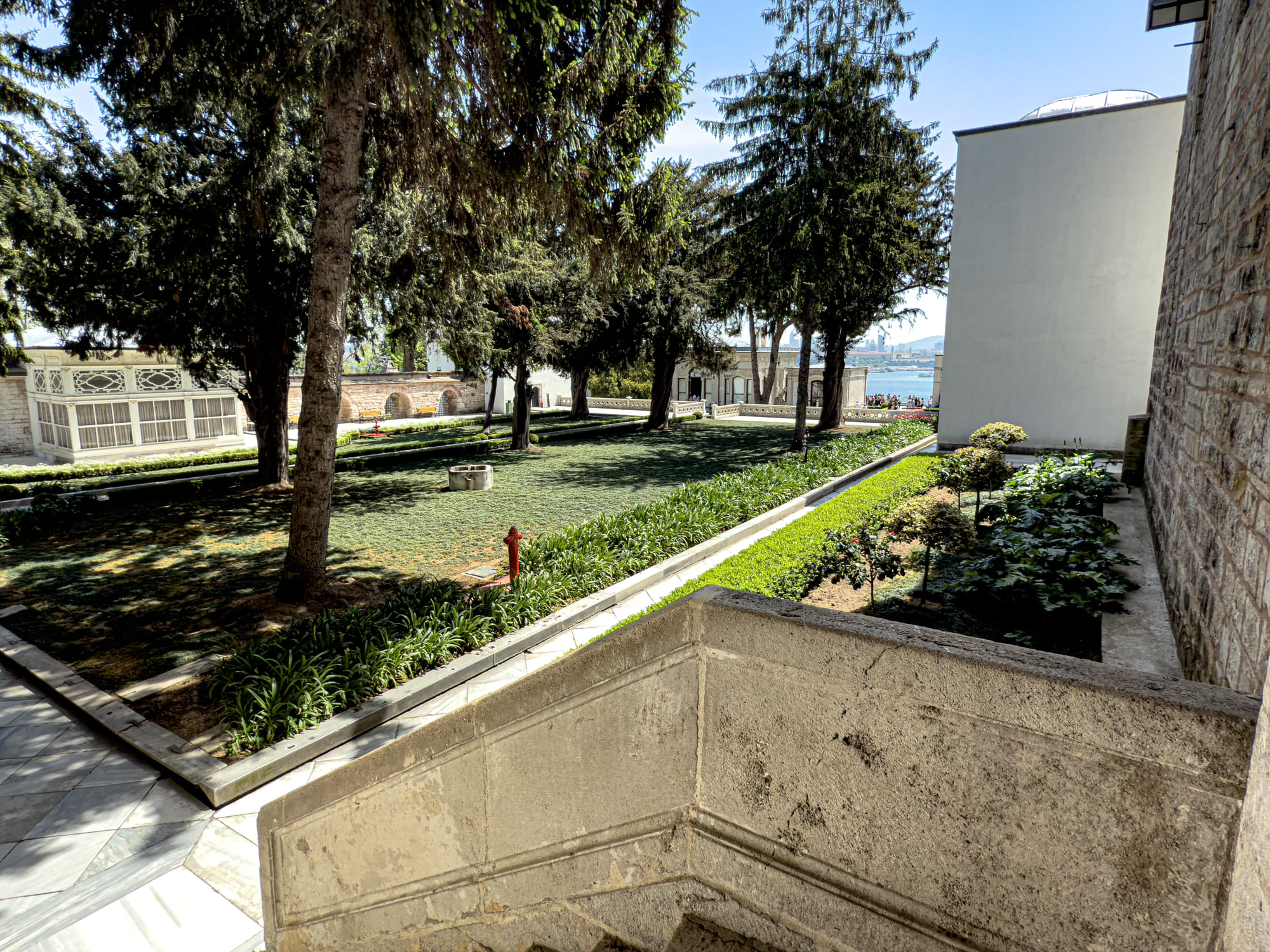
Quiet garden paths and lily ponds hint at the palace’s slower, more contemplative side
Walking these grounds, it's not hard to imagine the rhythmic pulse of daily life that once coursed through these spaces—kitchen fires glowing through the morning, guards standing still for hours, messages dispatched, sultans moving in silence, gardens being tended.
The harem: intrigue and intimacy
The Harem is easily one of the most evocative parts of the palace. Contrary to Orientalist clichés, it wasn’t just a space of indulgence—it was a strictly regulated world of power dynamics, education, and lineage.
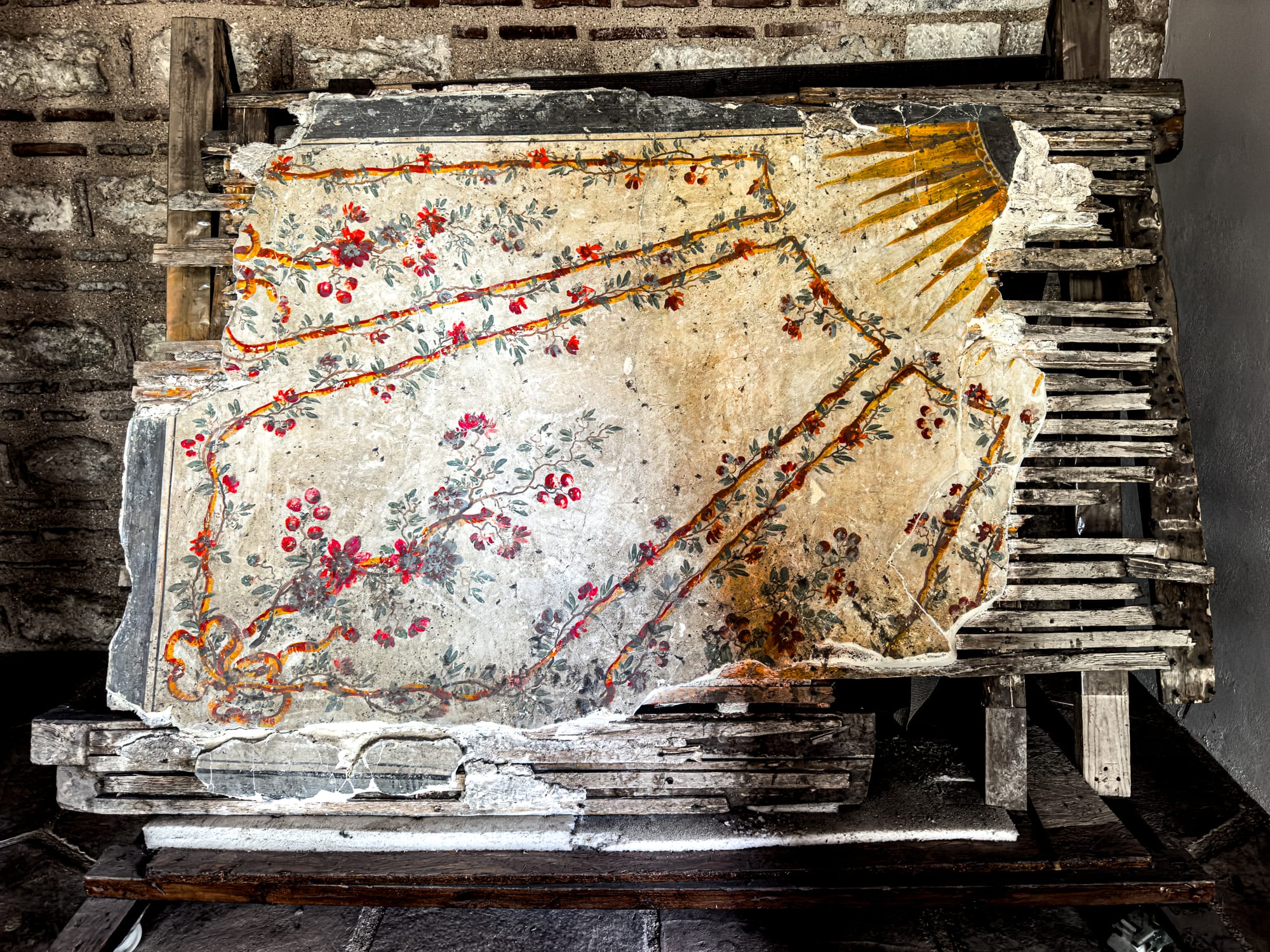
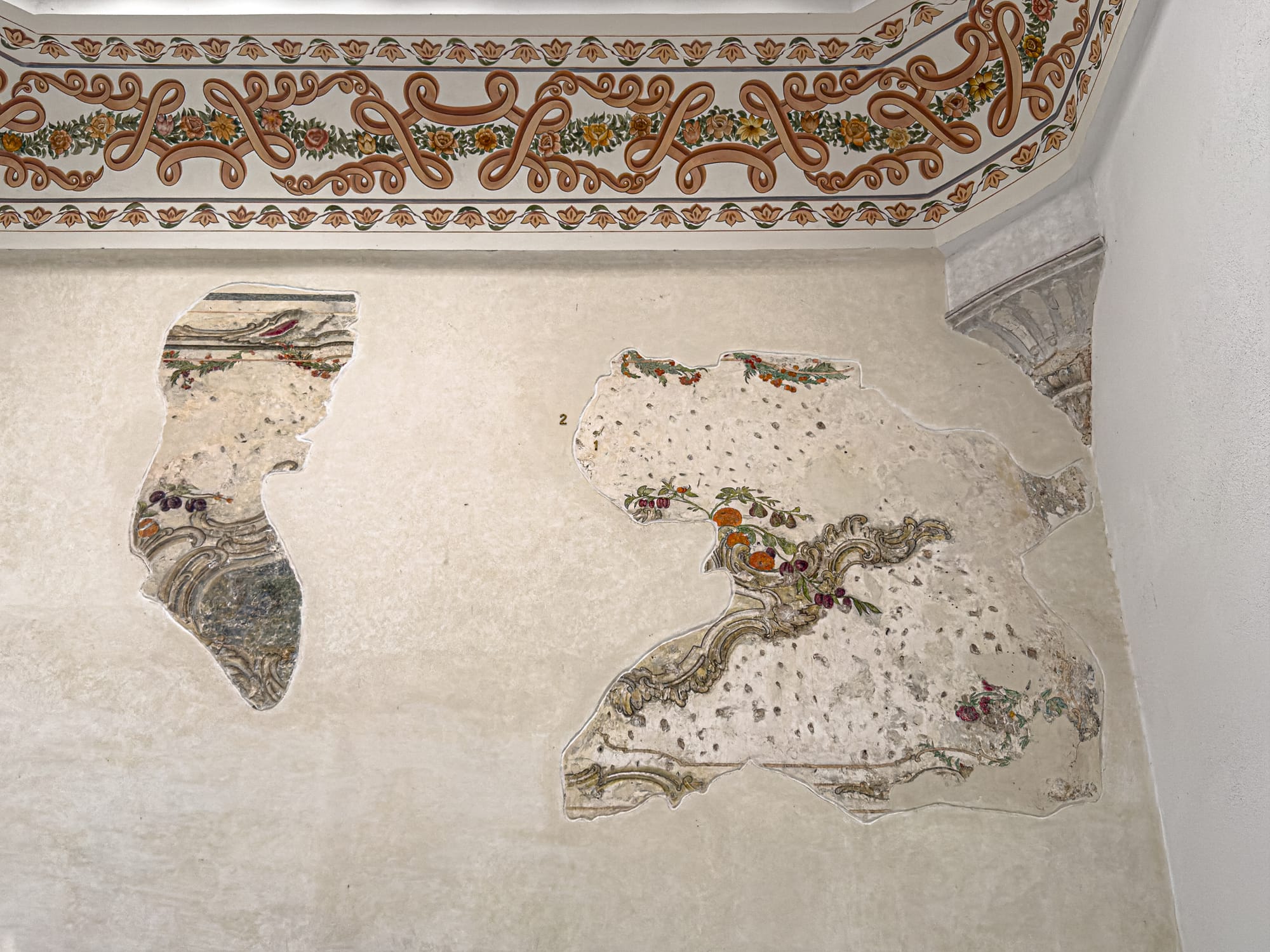
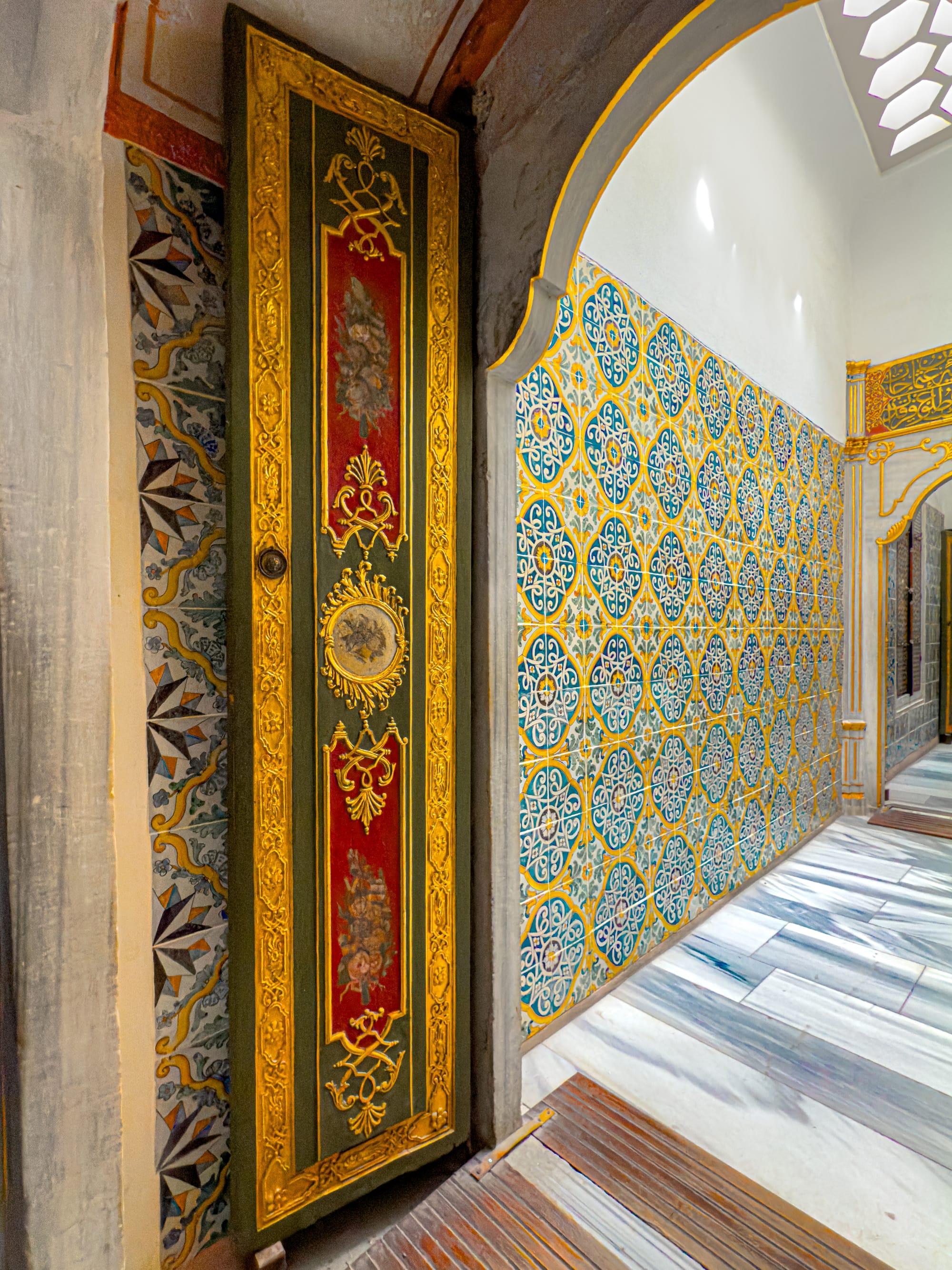
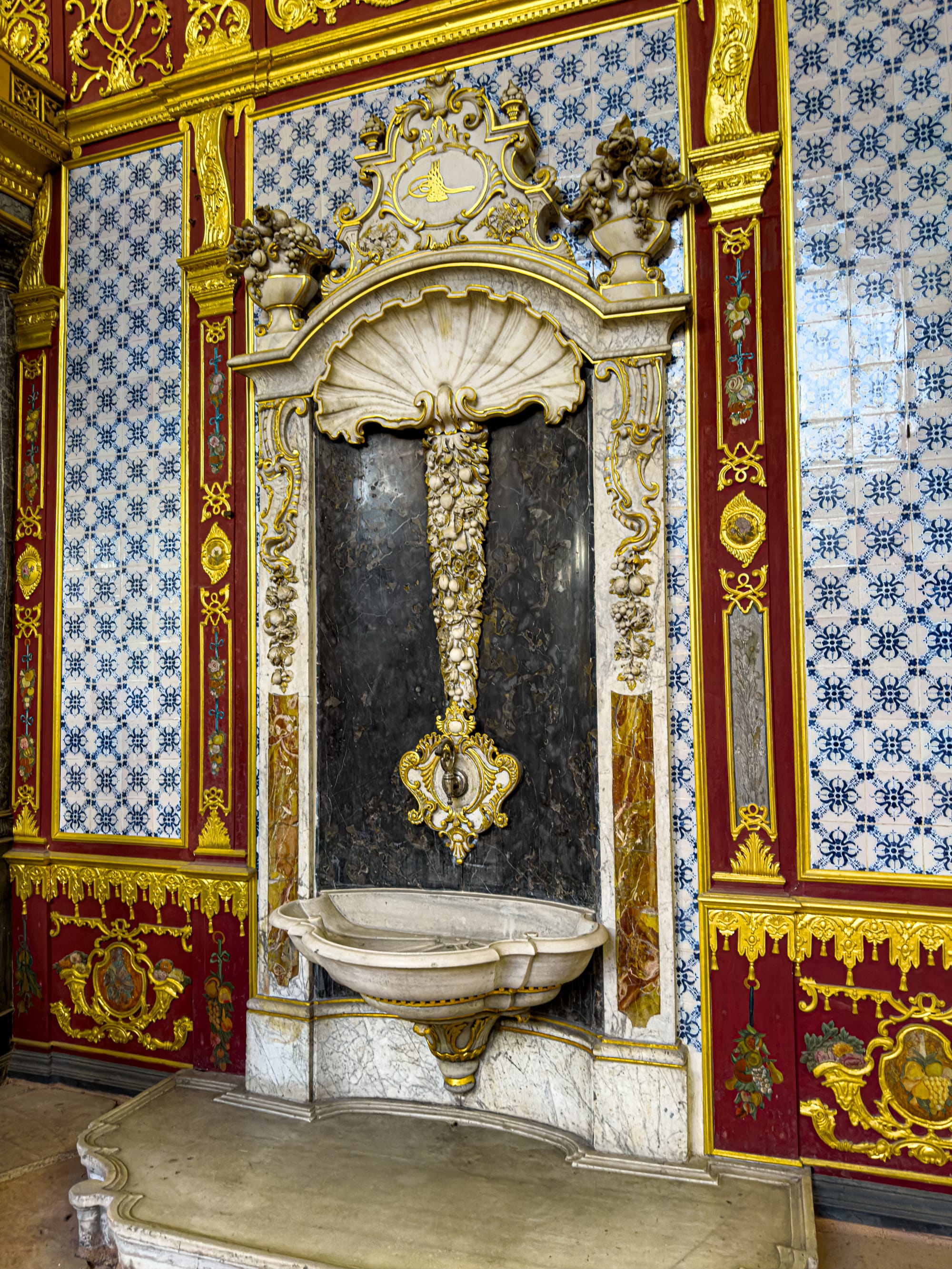
Fragments of floral murals and glimmering tiles reveal layers of Topkapi’s decorative imagination
The sultan’s mother (Valide Sultan) held immense power here, overseeing the network of concubines, wives, and black eunuchs. Each woman in the Harem was on a path of potential advancement, trained in music, languages, court protocol, and politics. Rooms were richly decorated, yet private—built not for spectacle but for layered forms of control and containment.
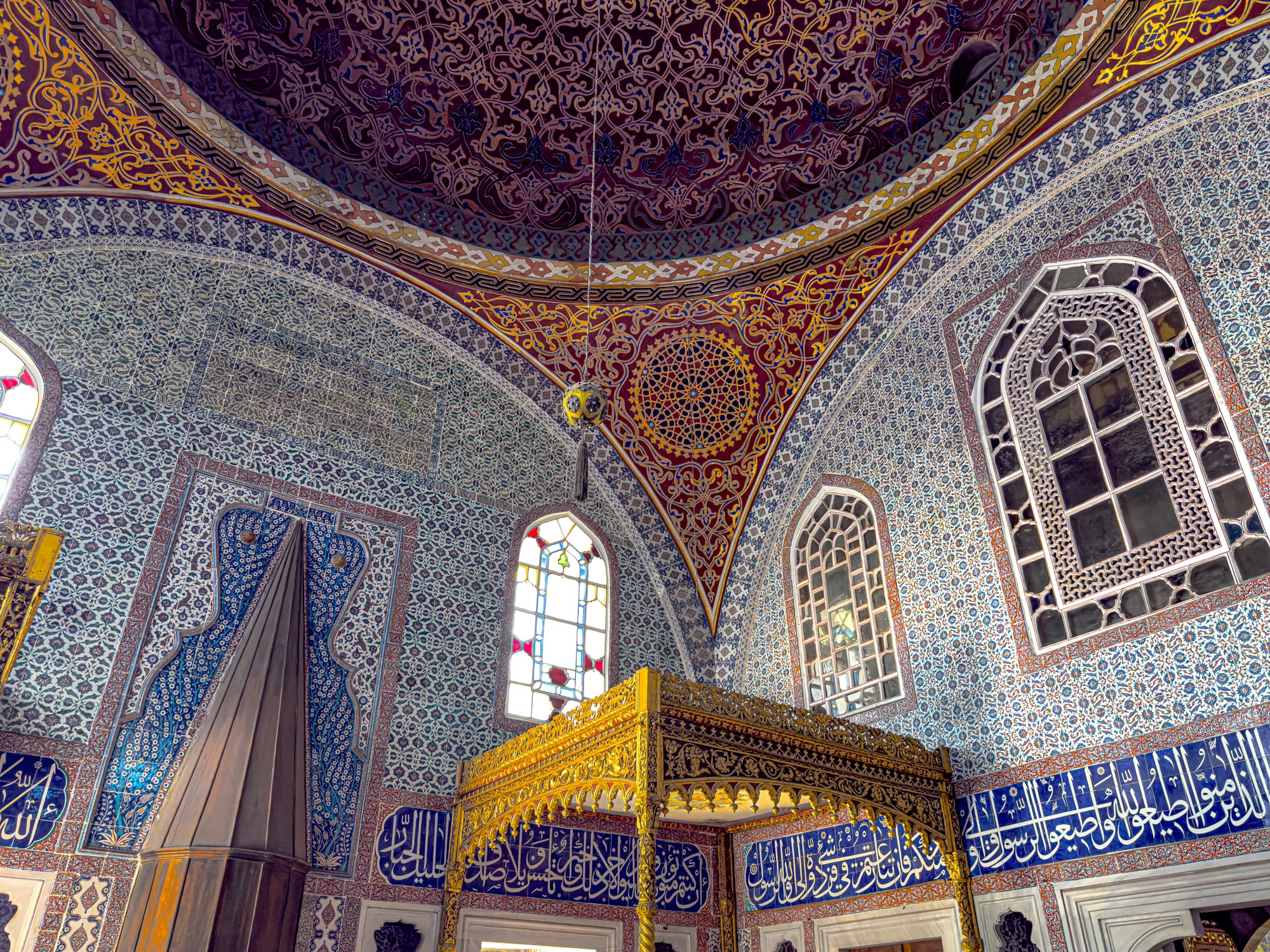
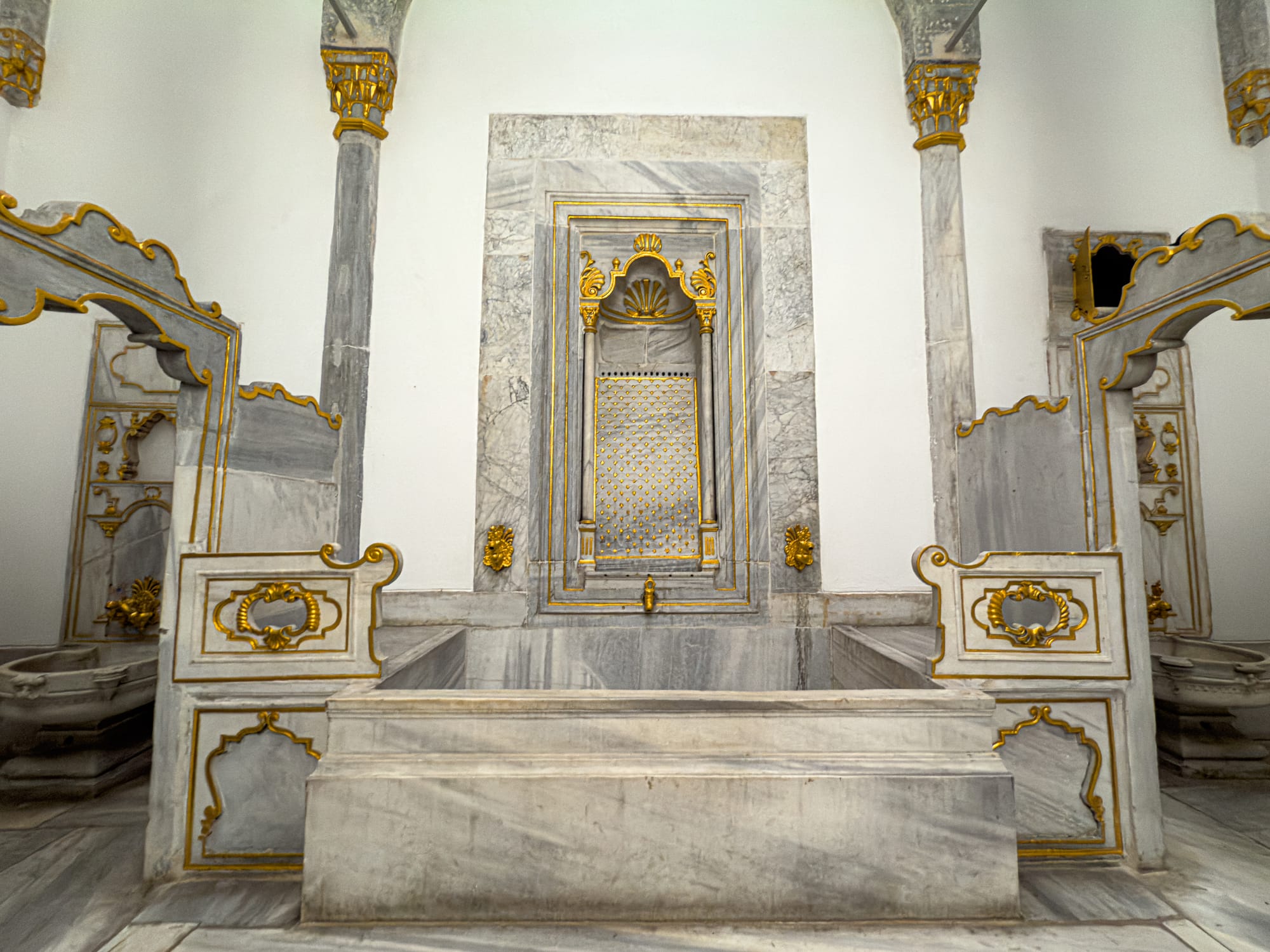
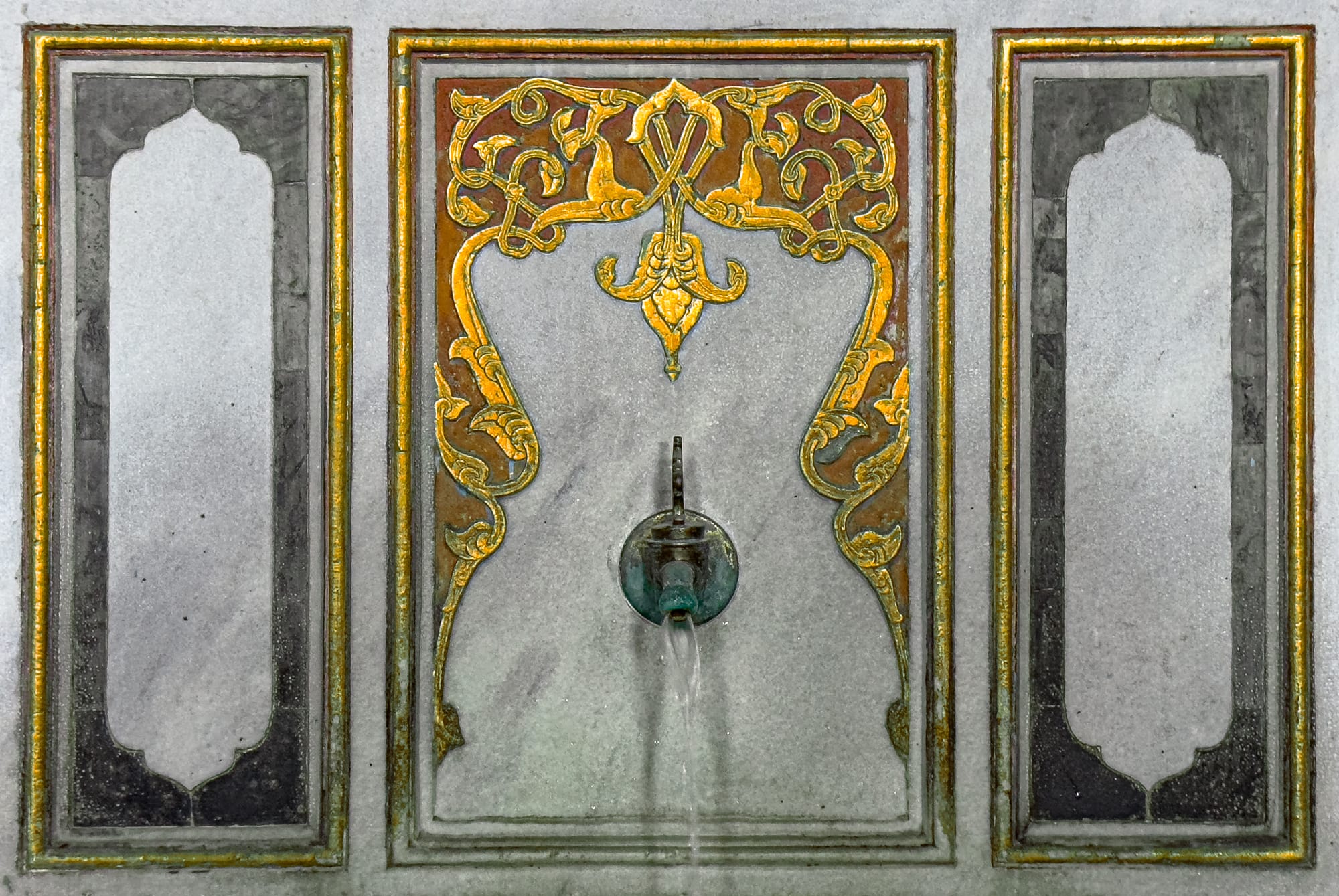
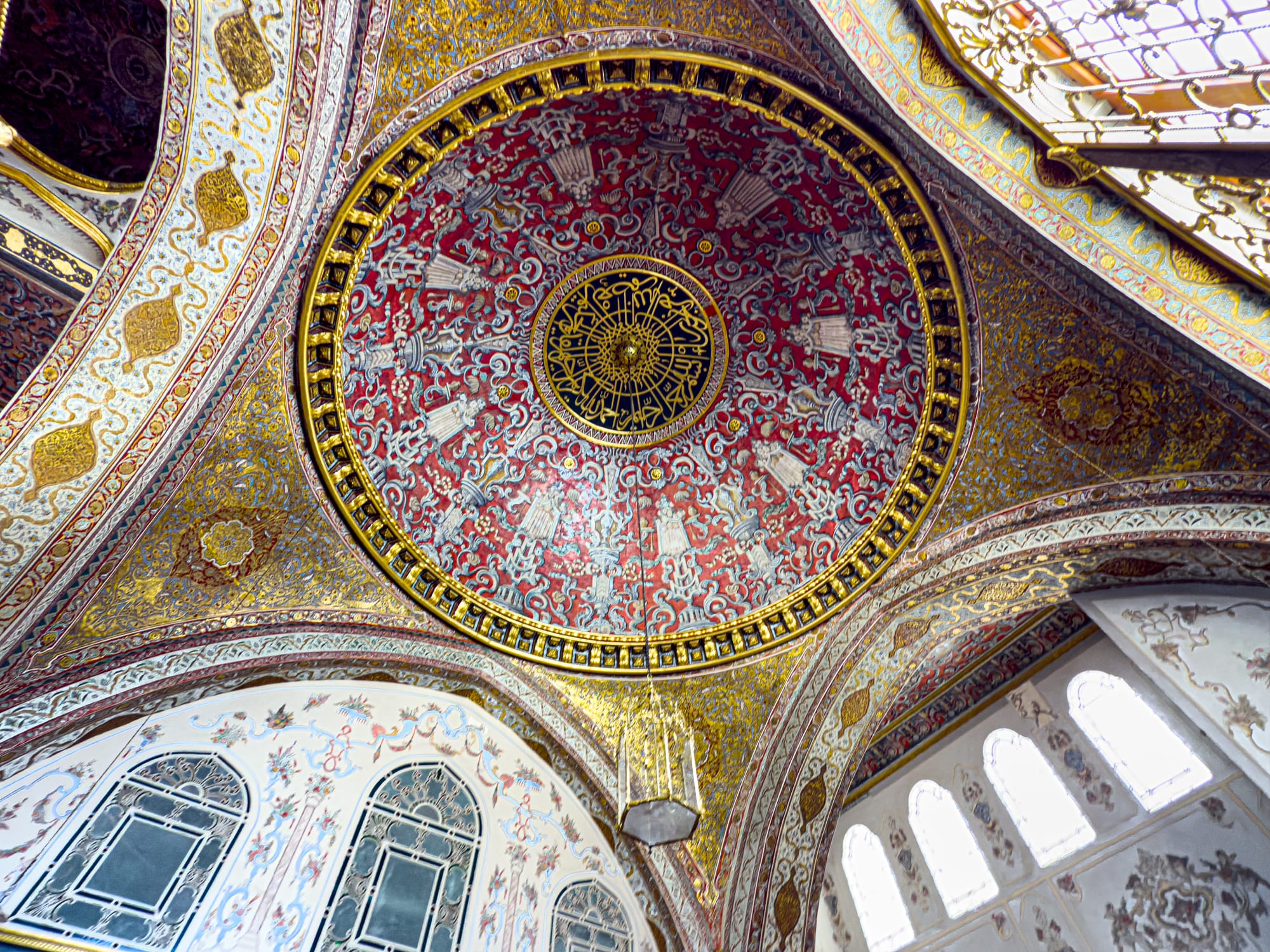
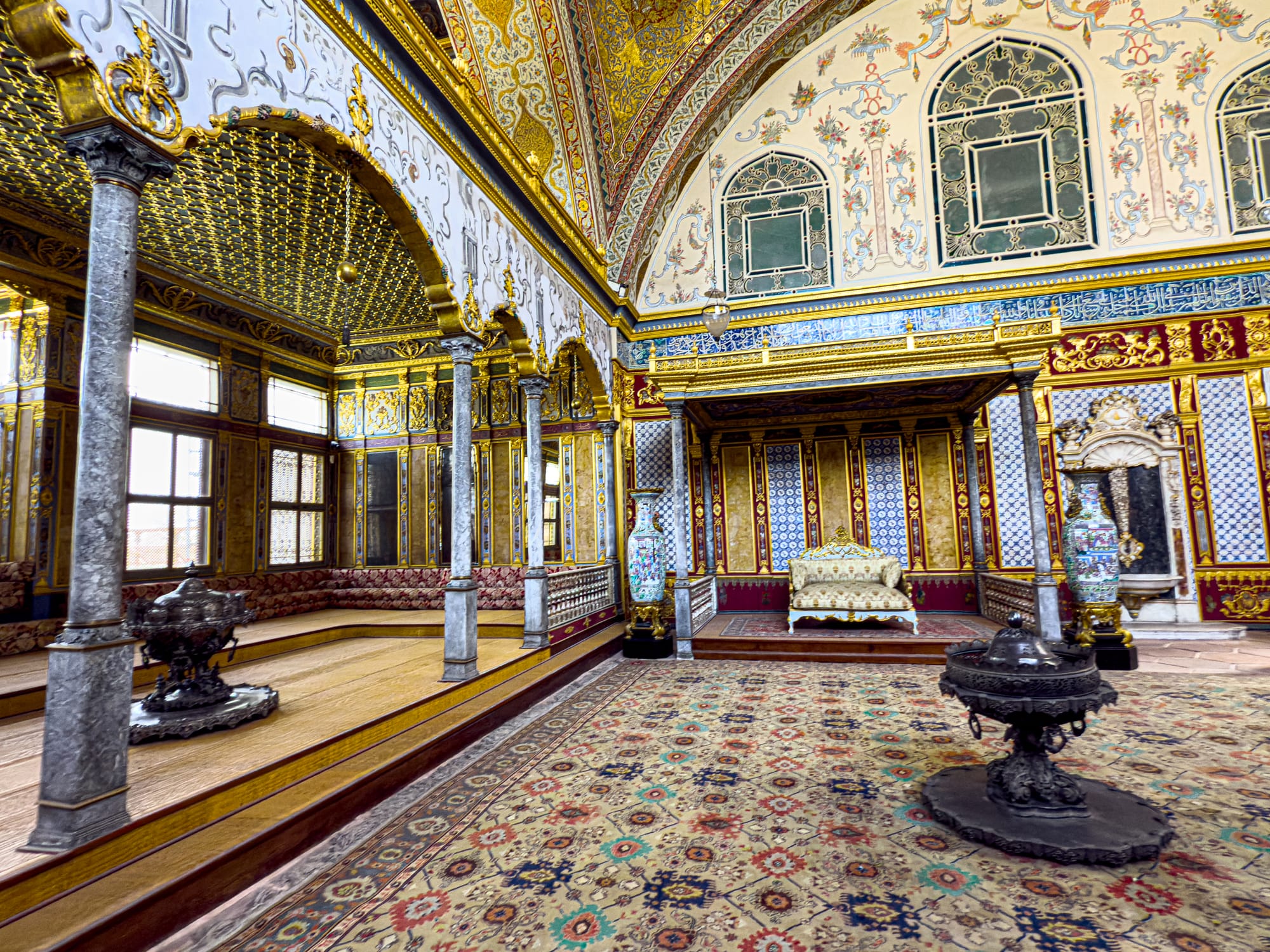
Ceremonial chambers, marble fountains, and domed ceilings reflect the opulence of Topkapi’s private world
The tiled chambers of the Harem reveal extraordinary craftsmanship: İznik ceramics in cobalt and emerald, floral and calligraphic motifs flowing across walls and domes. Golden grilles shielded views, and doors within doors created a sense of both intimacy and surveillance. You’ll move through royal baths, courtyards, small prayer spaces—and feel a completely different rhythm from the more public-facing parts of the palace.
The treasury: excess and symbolism
The Imperial Treasury displays an astonishing array of objects: jewel-encrusted daggers, ceremonial armor, gilded thrones, and enormous emeralds and rubies. Perhaps most famous is the Topkapi Dagger, with its massive green stones and clockwork detailing, and the Spoonmaker’s Diamond, said to be one of the largest in the world.
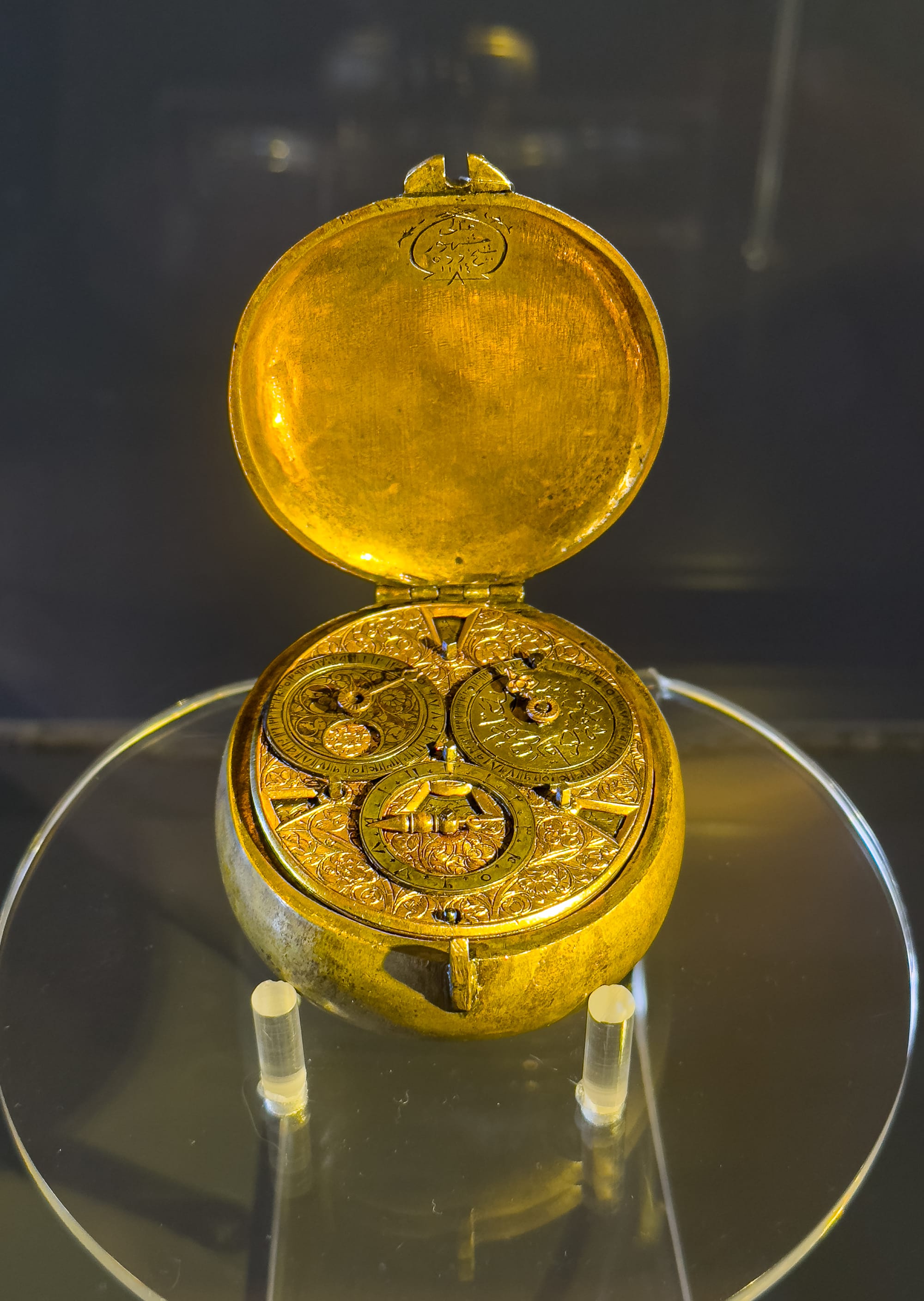
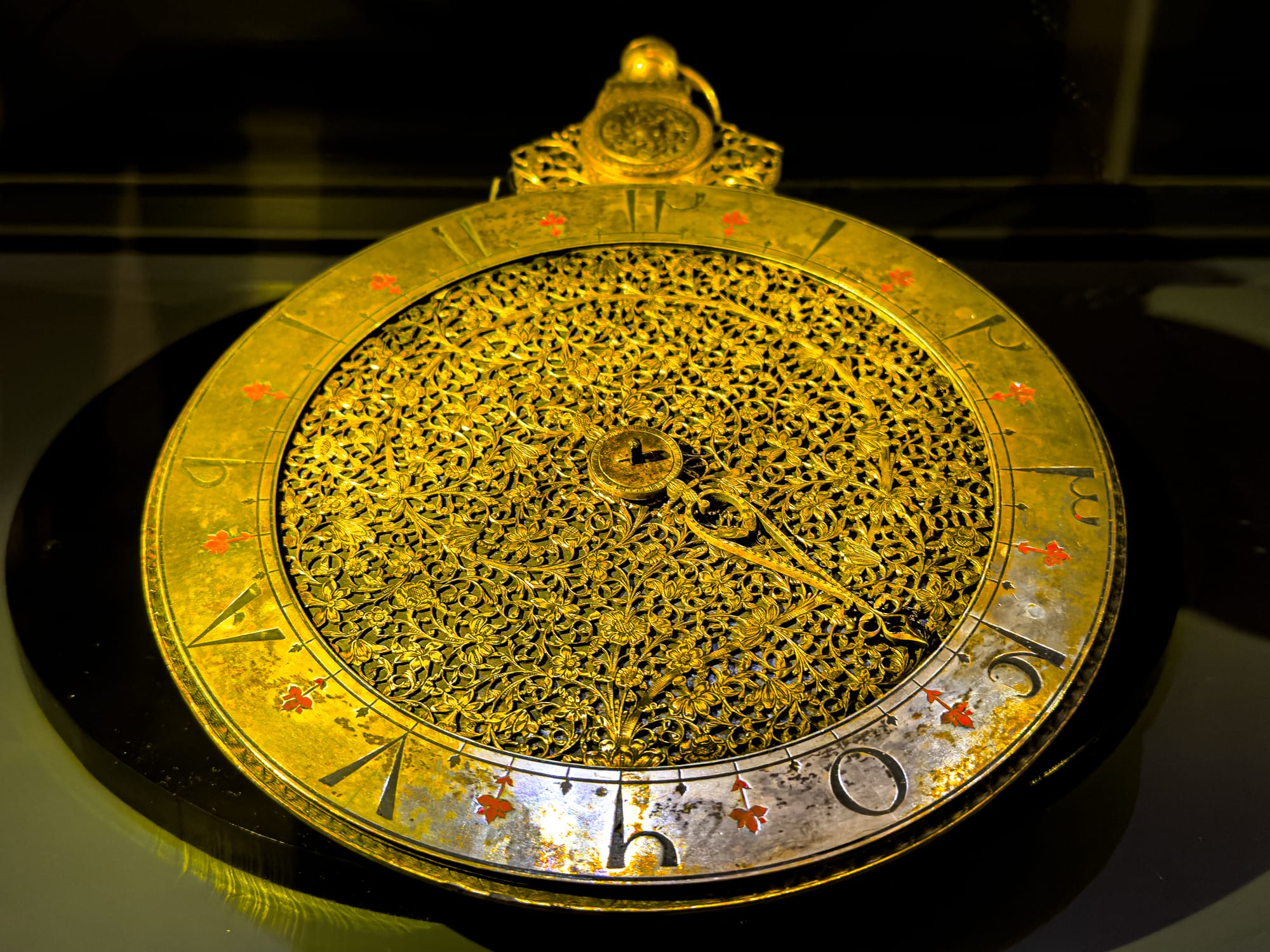
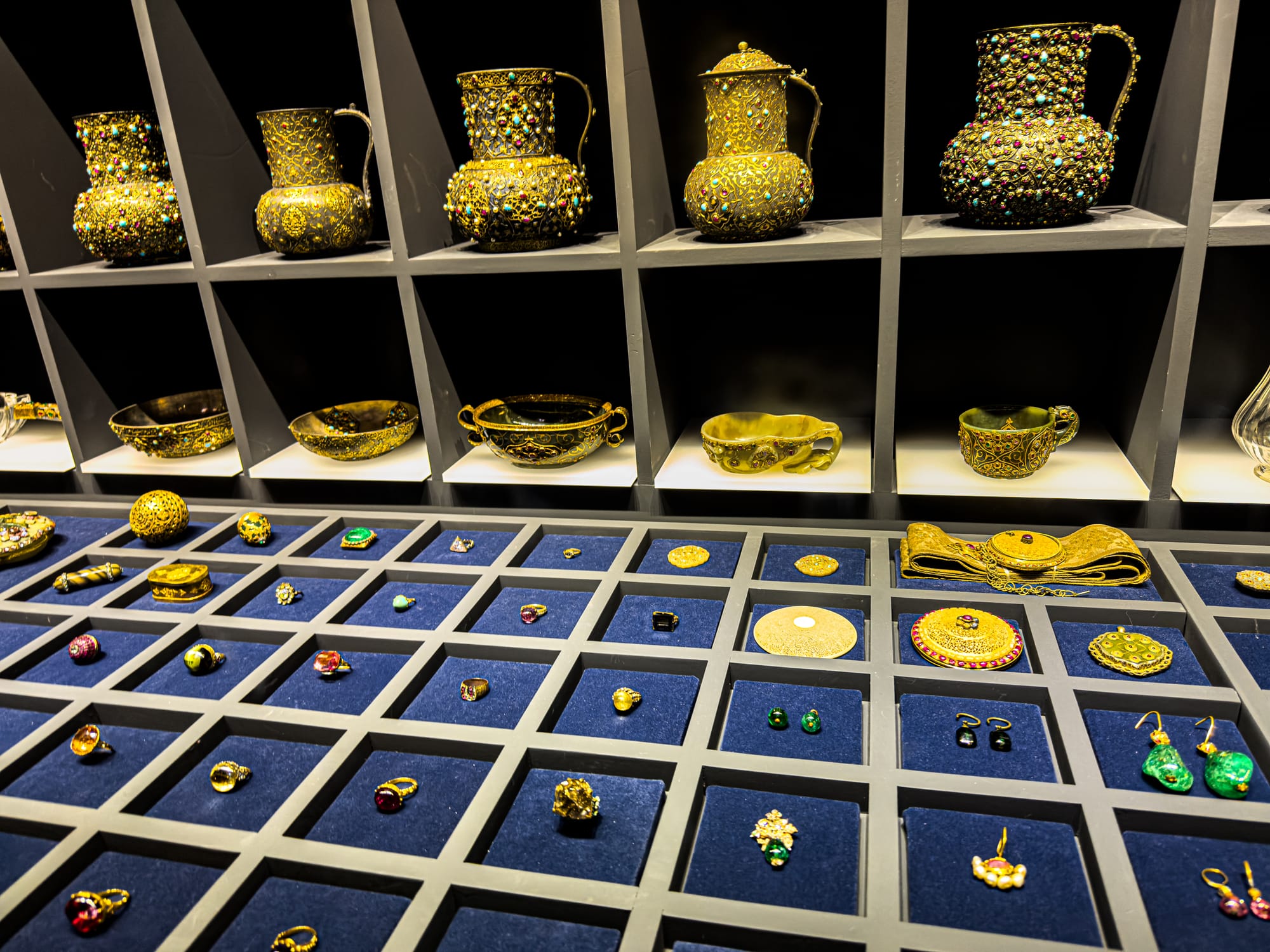
Gold timepieces, jeweled vessels, and ornate treasures from the palace’s dazzling imperial collection
Yet beyond their value as objects, these items reflect a symbolic economy—one where excess communicated not just wealth but divine favor, where visual dazzle reinforced imperial authority. The sultans used these items sparingly, often ceremonially, yet their presence spoke volumes.
The palace kitchens and everyday life
Often overlooked, the palace kitchens (on the eastern side of the Second Courtyard) were vital to the daily functioning of Topkapi. They produced food for up to 4,000 people daily and were themselves centers of innovation—particularly in Ottoman cuisine, medicine, and material arts like ceramics.
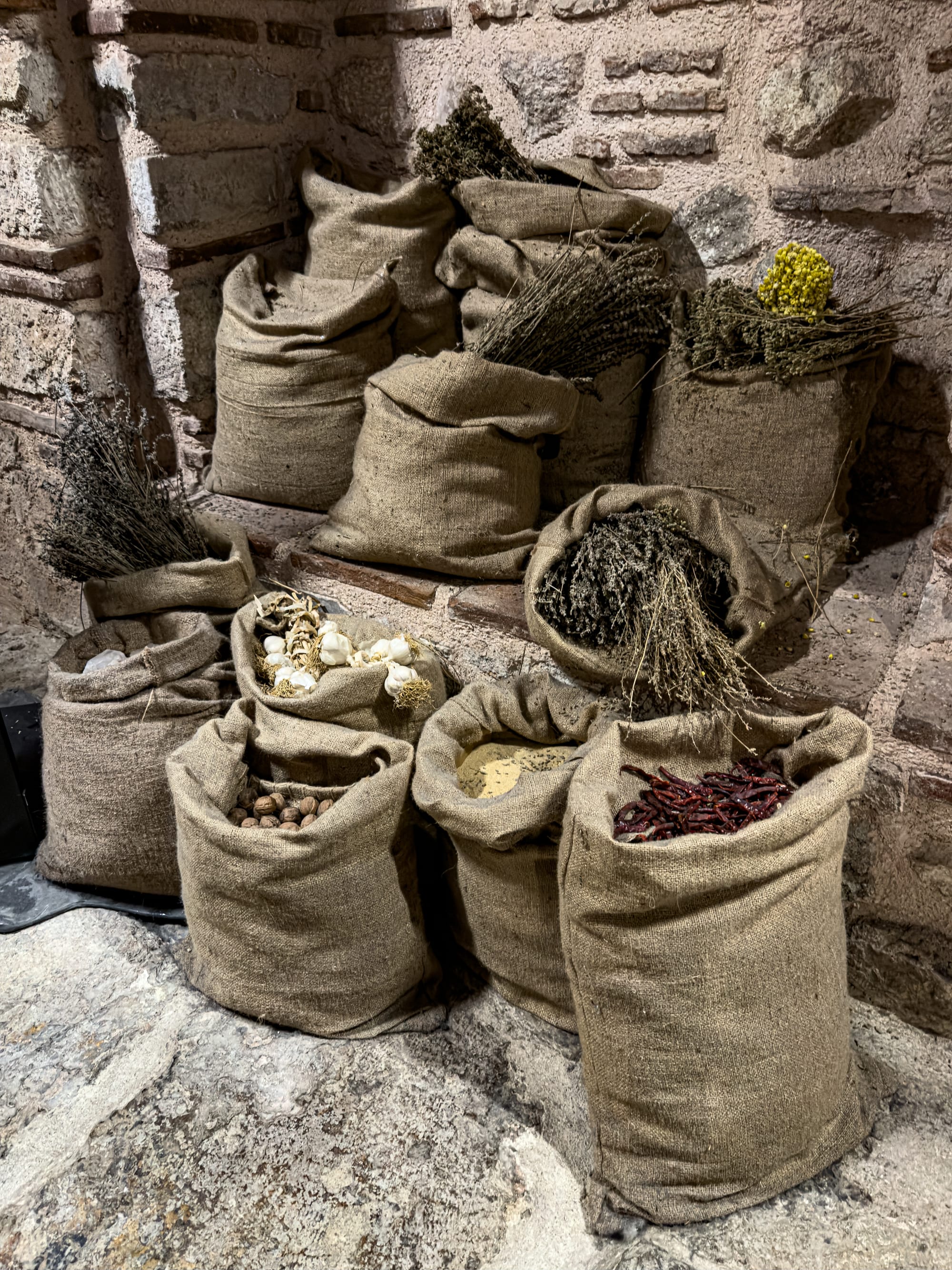
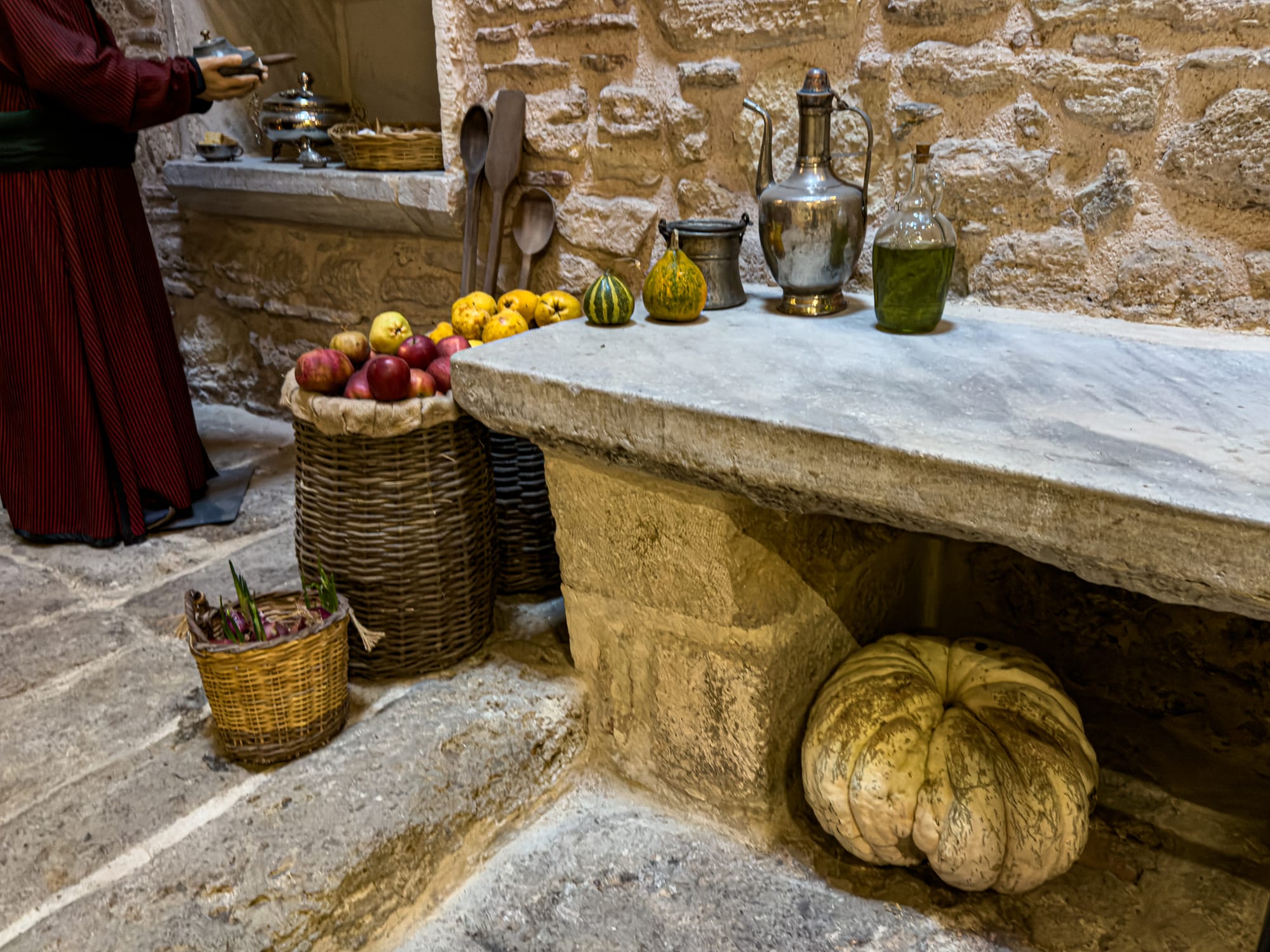
Recreation of an Ottoman palace kitchen featuring dried herbs, spices, fruits, and traditional utensils
Inside, you’ll find massive cauldrons, intricate chimney designs, and displays of porcelain and celadon, much of it imported from China and considered to have magical properties (like detecting poison).
There’s also something grounding about walking through these less-glamorous wings: a reminder that empire depended on labor, repetition, and infrastructure.
The calligraphy and imperial edicts
Among Topkapi’s most distinctive features is the sheer quantity and quality of calligraphy: Qur’anic inscriptions, imperial monograms (tughra), and poetry flow across doors, arches, and domes.
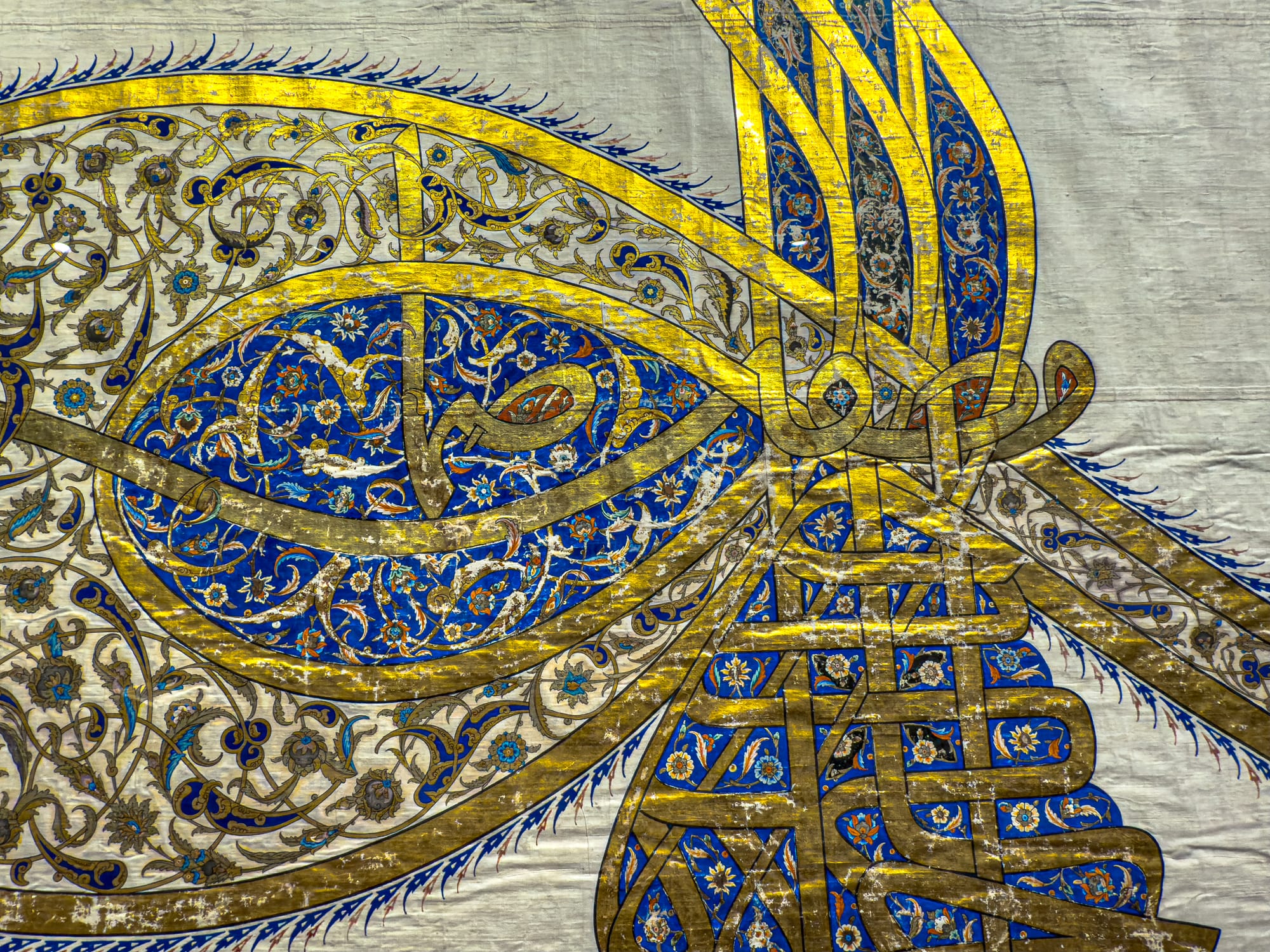
Calligraphy wasn’t just decoration—it was power made visible. The sultan’s edicts were sealed with calligraphic precision. Religious phrases marked transitions between spaces. Even the Harem had walls softened by floral script, signaling both beauty and control.
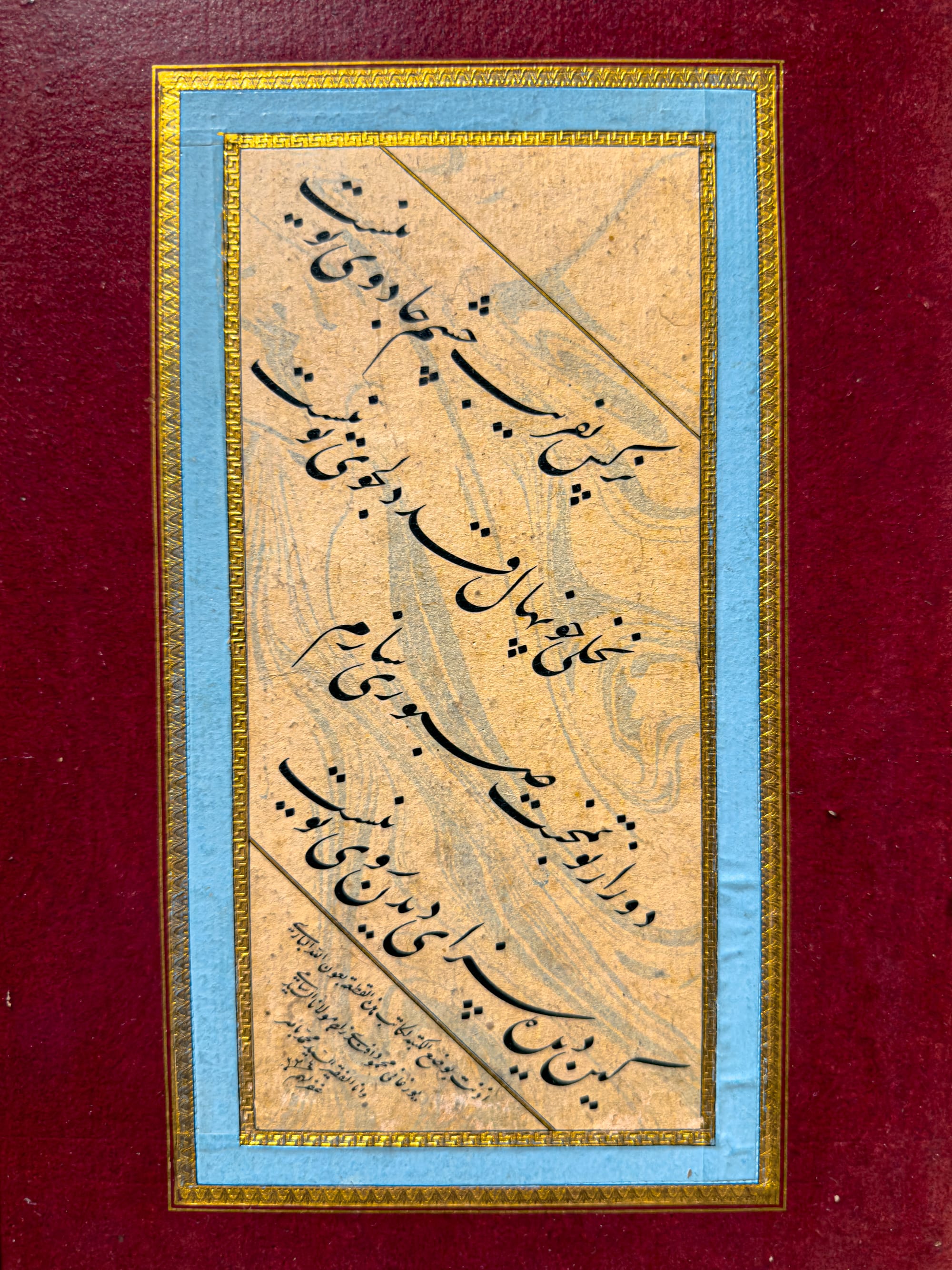
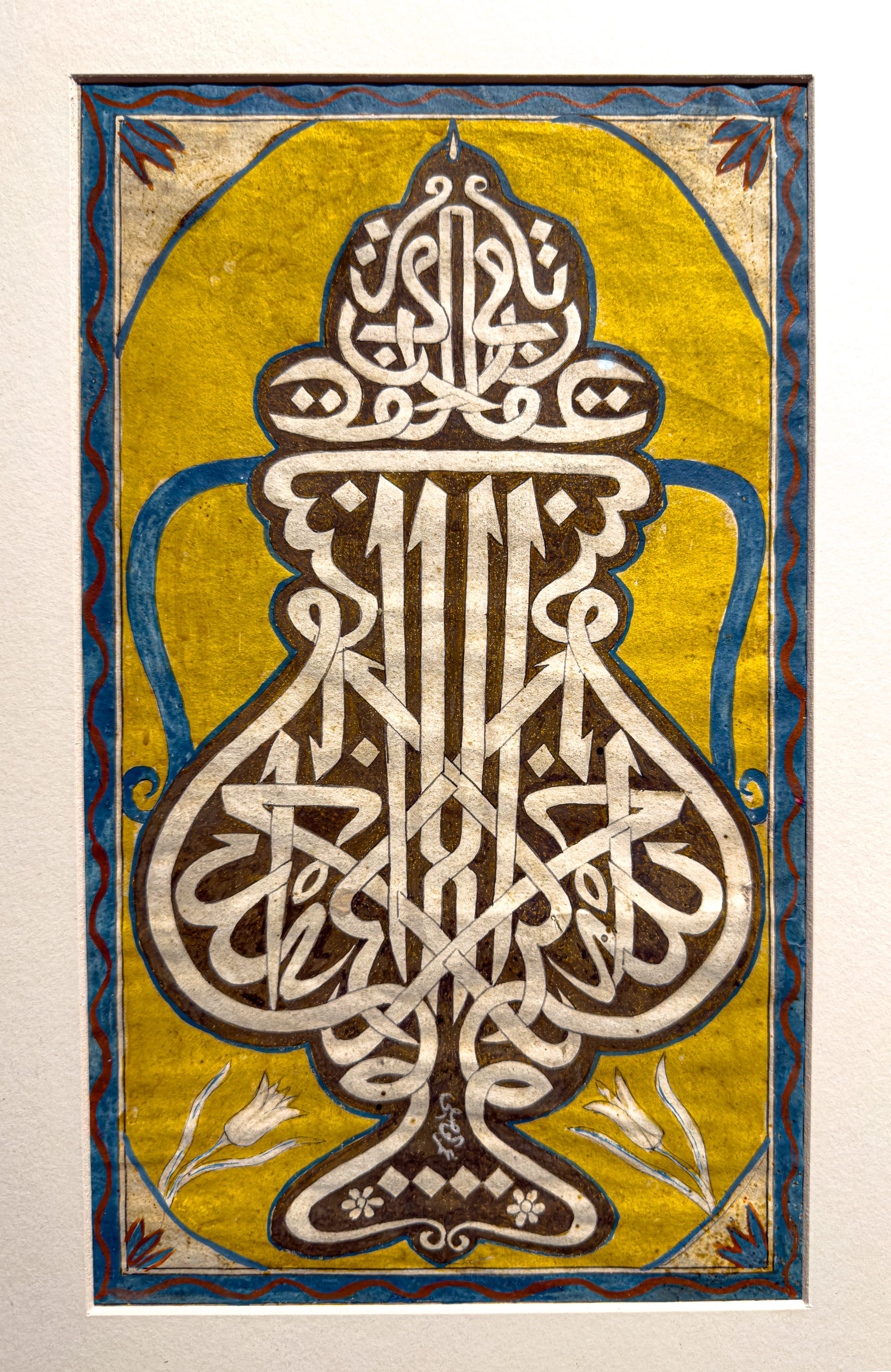
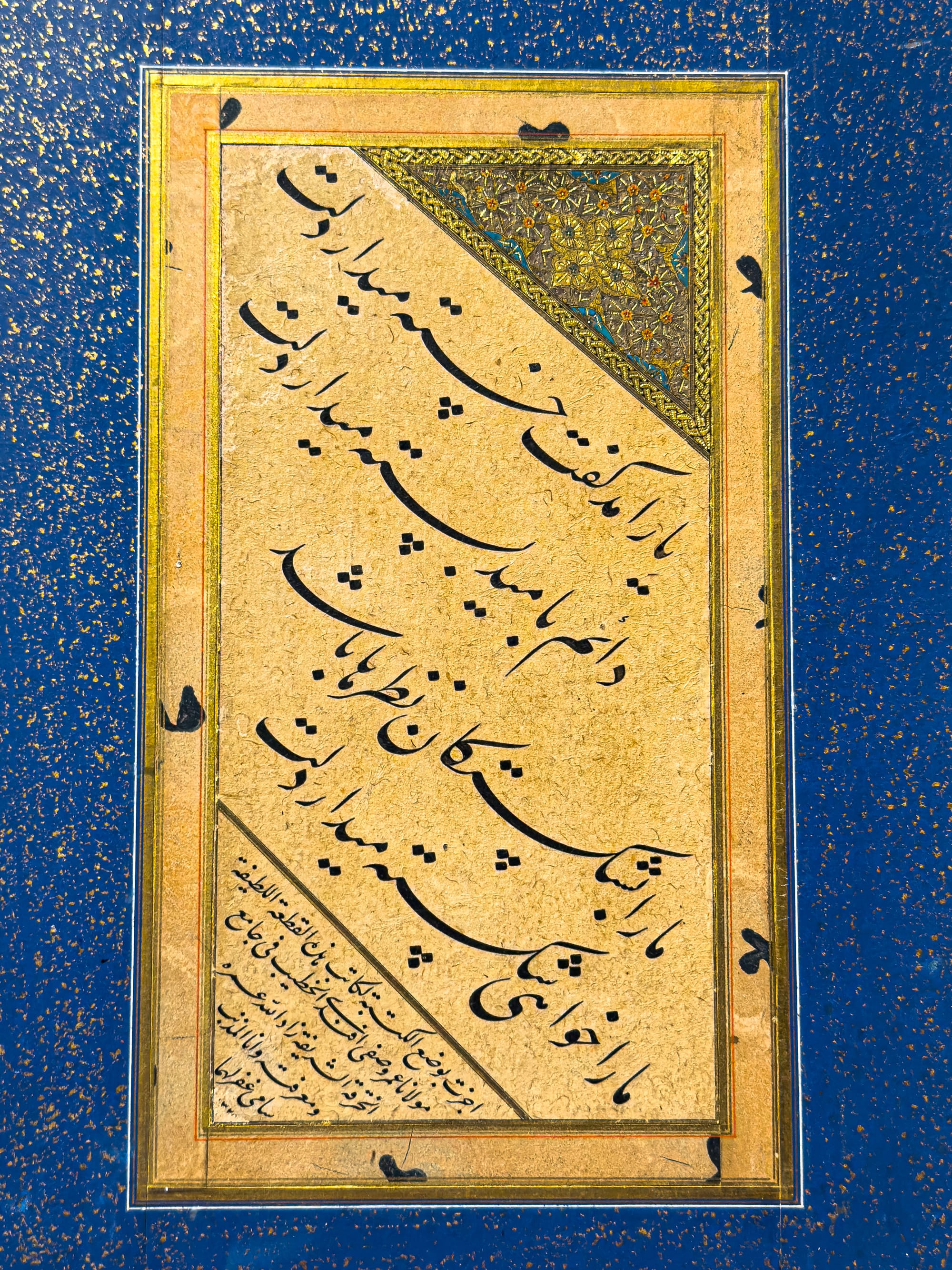
Ottoman-era calligraphy plates featuring poetry, Qur’anic verses, and imperial insignias on illuminated paper
In one room, you might find a centuries-old firman (royal decree) displayed beside the robe of a sultan. In another, lines from Rumi curve across a dome, reminding visitors that faith, governance, and aesthetics were deeply interwoven in Ottoman thought.
Imperial garments and court fashion
Topkapi’s textile and costume collections are exceptional—not only for their rarity but for how vividly they evoke the physical presence of the palace’s former inhabitants.
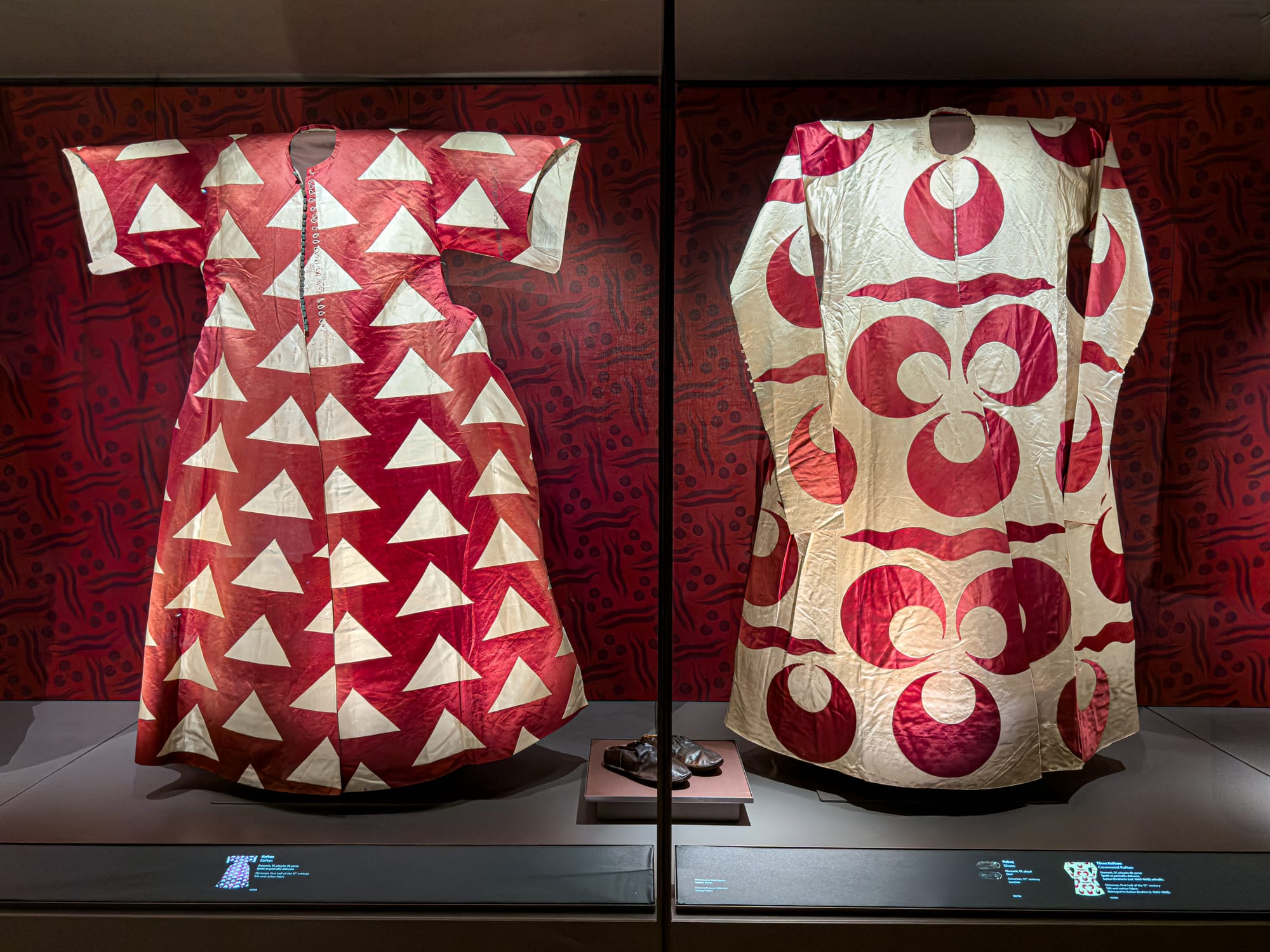
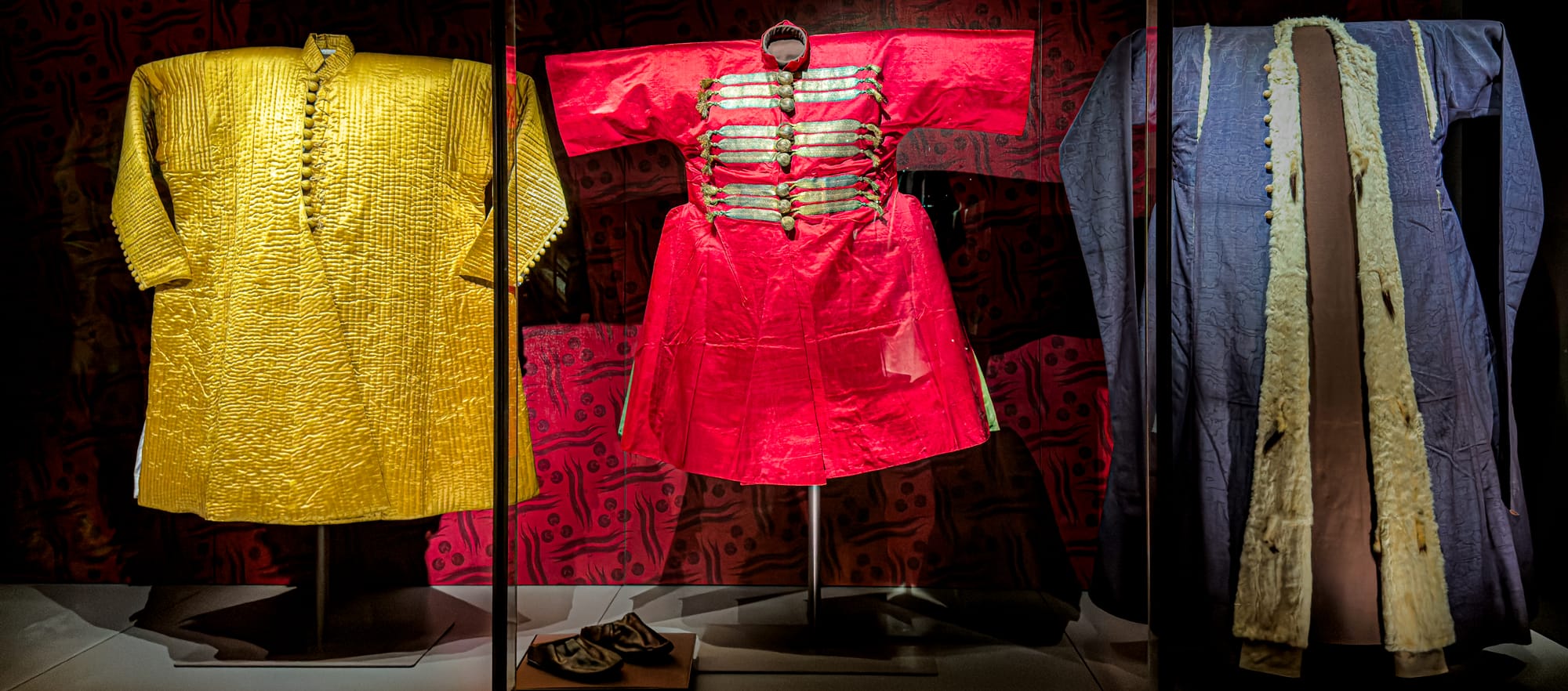
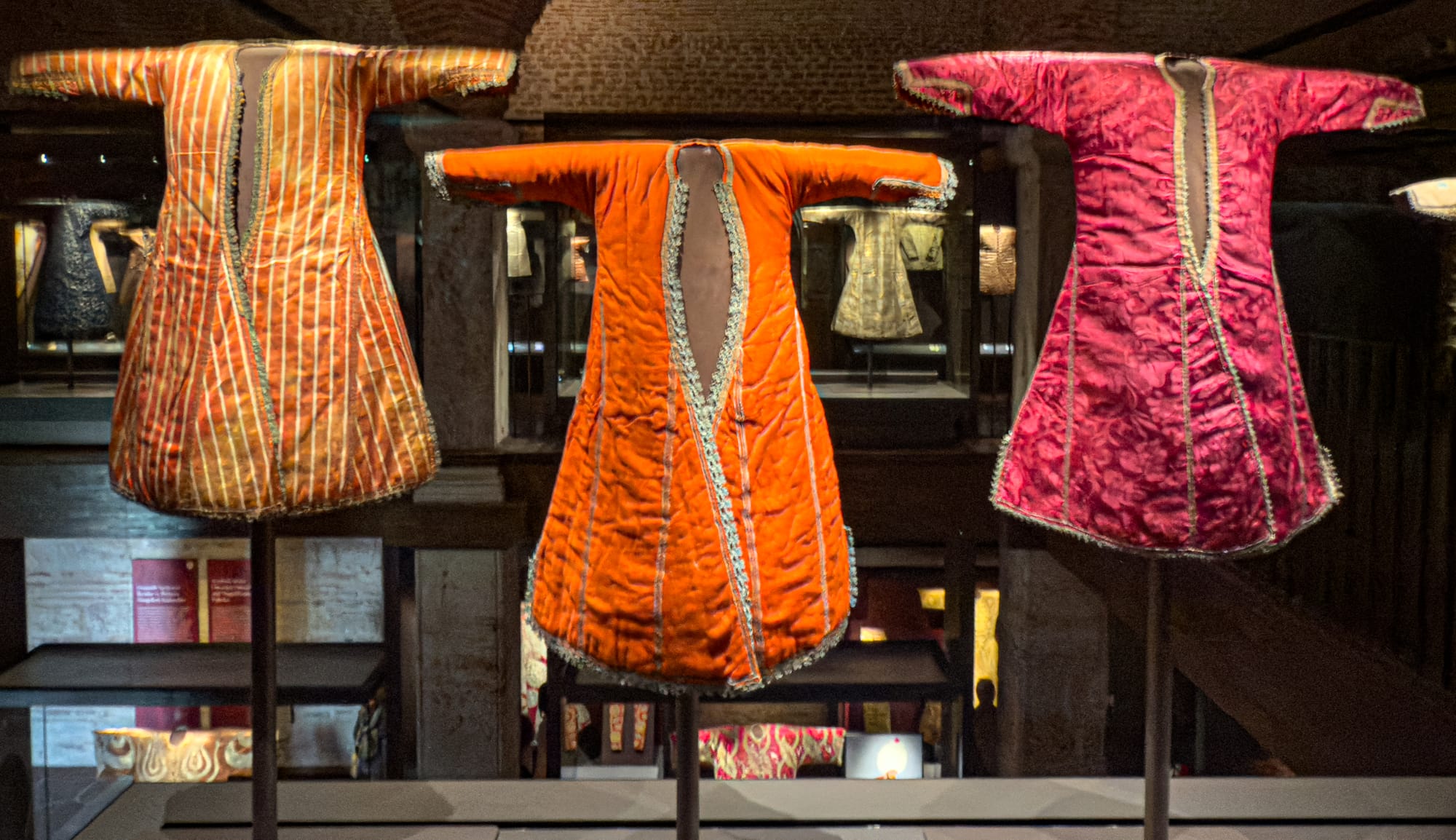
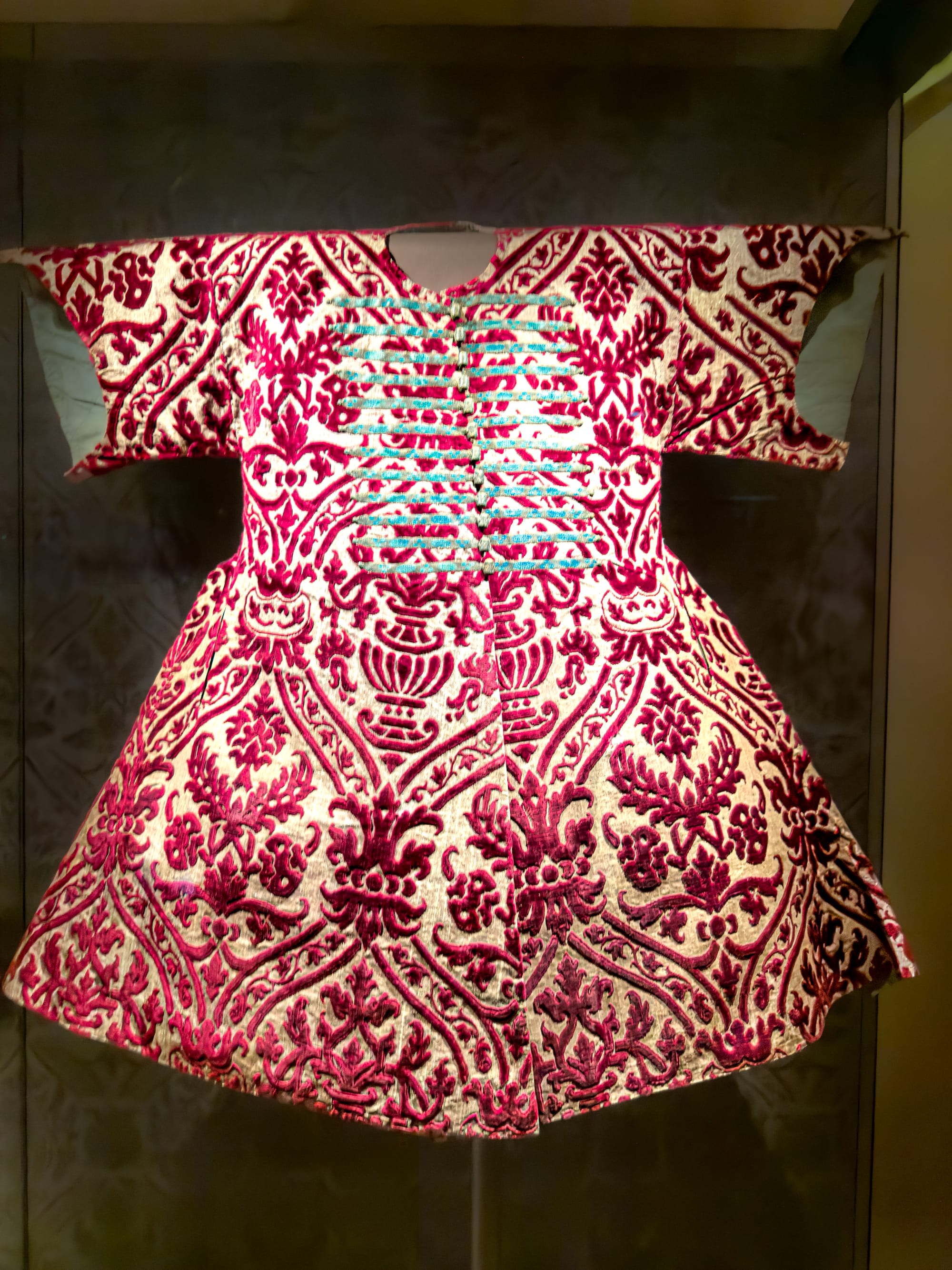
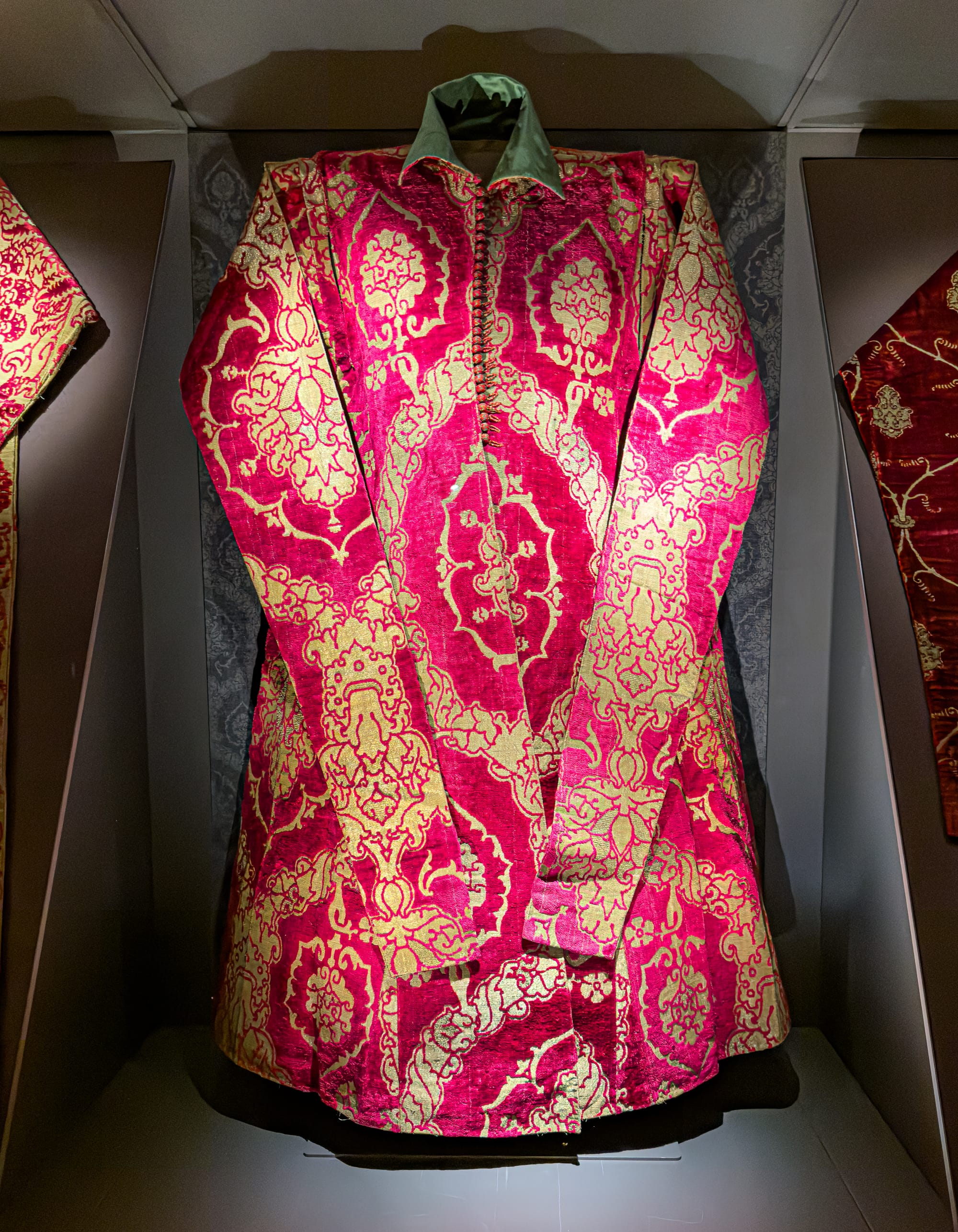
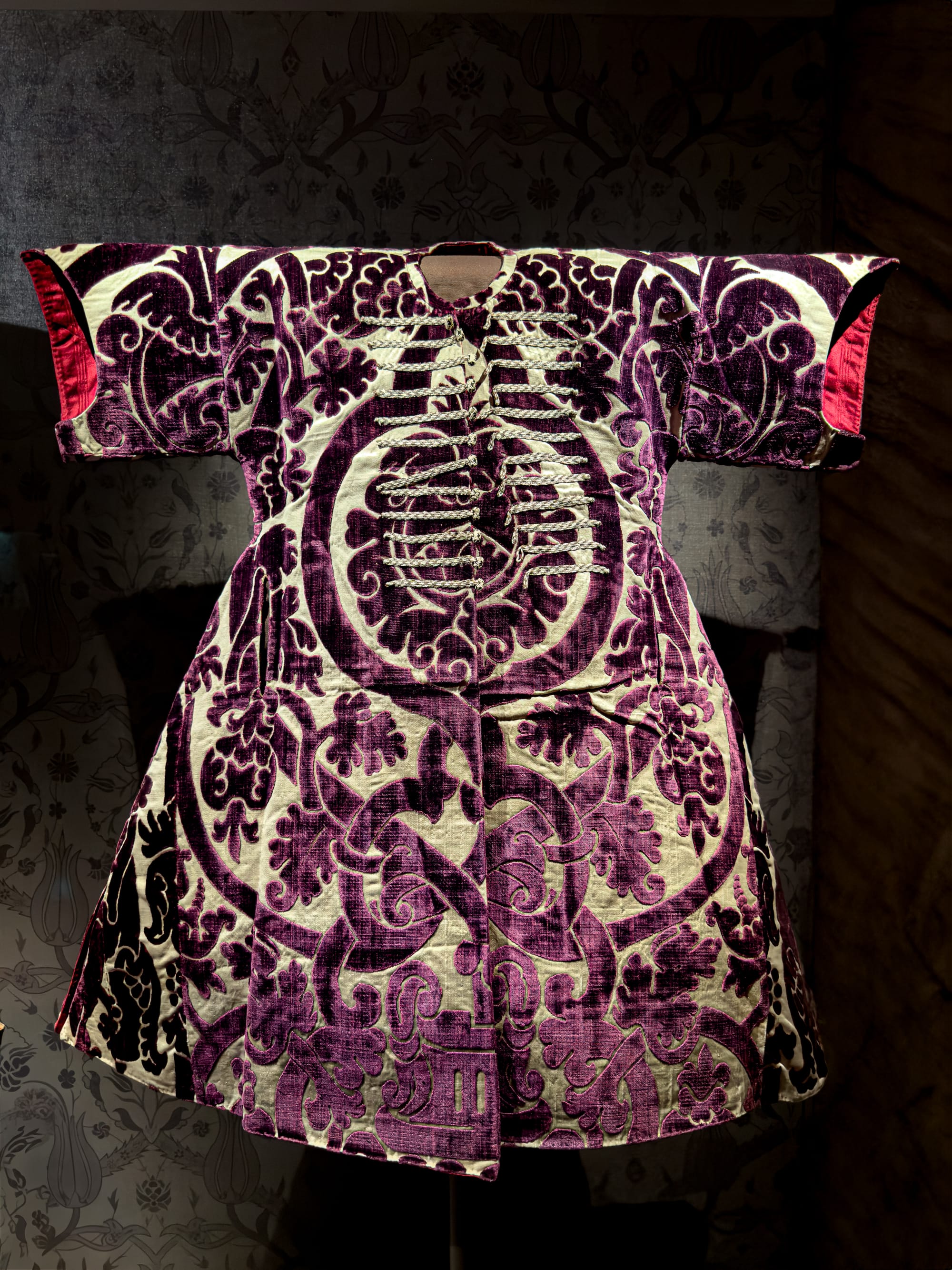
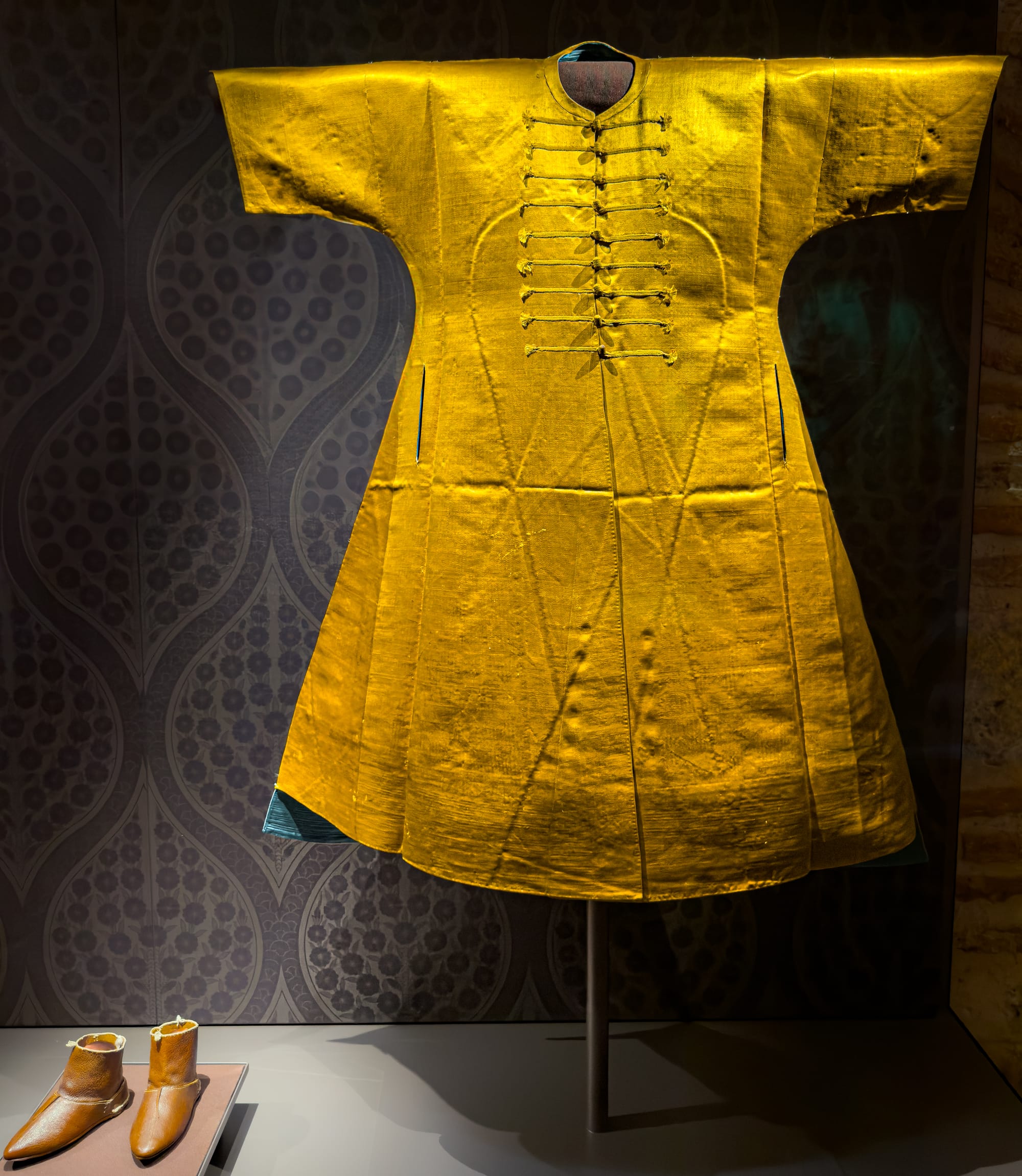
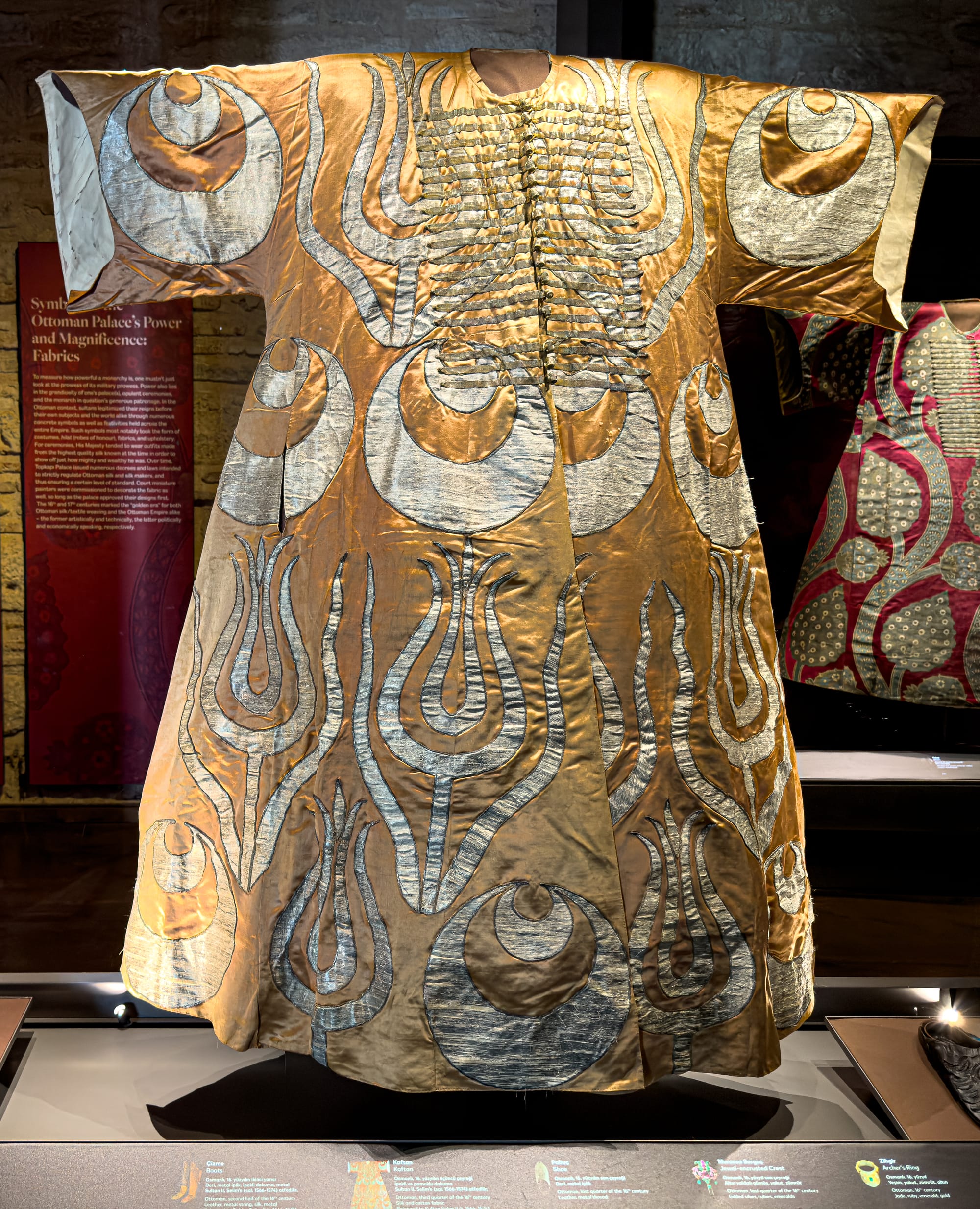
Imperial kaftans from the Ottoman court, woven with silk, gold thread, and bold dynastic motifs
Velvet kaftans embroidered with silver thread, bright silk robes, child-sized garments for princes, heavily ornamented ceremonial wear—each piece suggests a choreography of daily life that was both intimate and codified. Many of these robes were custom-made in palace ateliers, following strict hierarchies of color, material, and design.
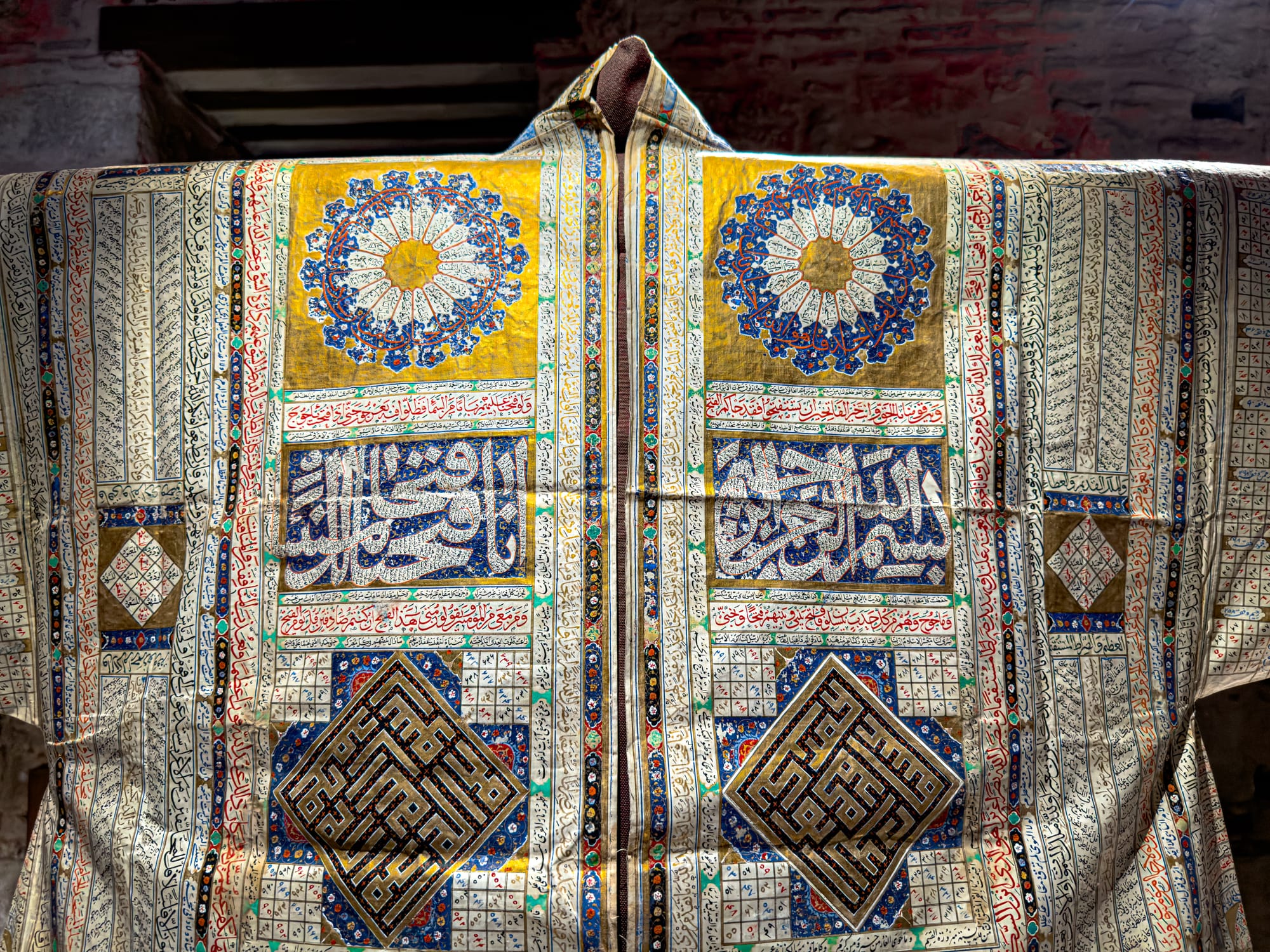
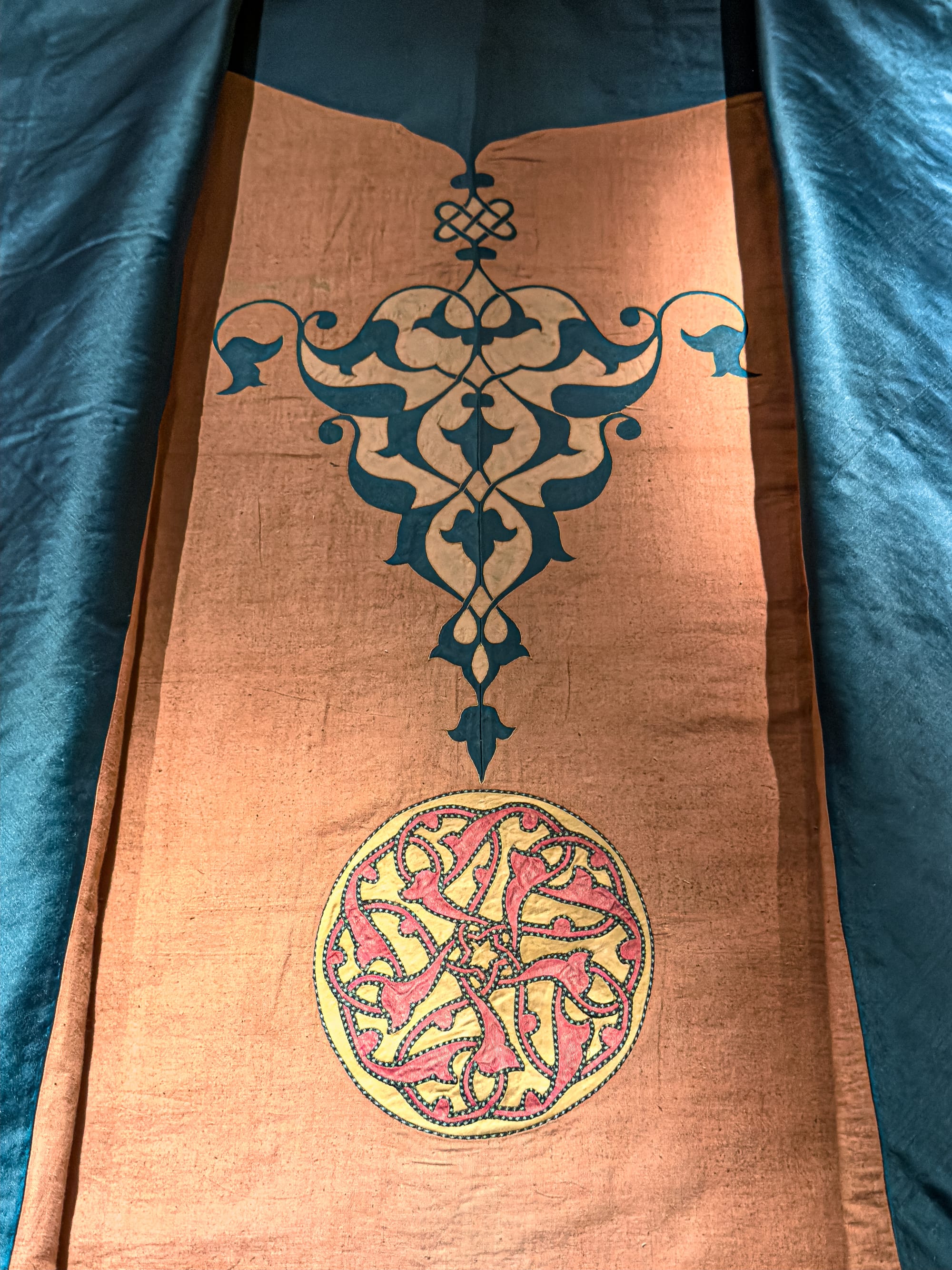
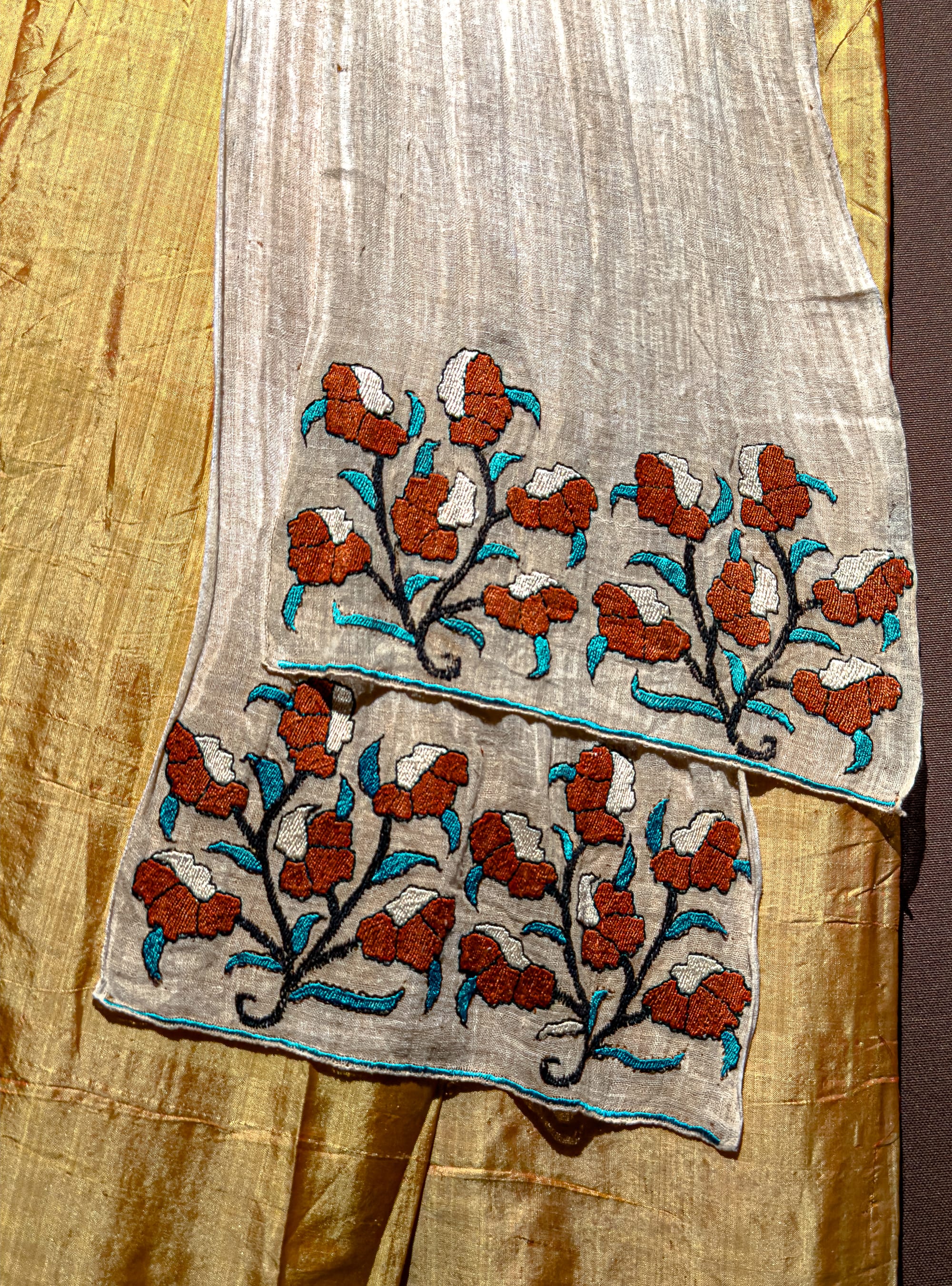
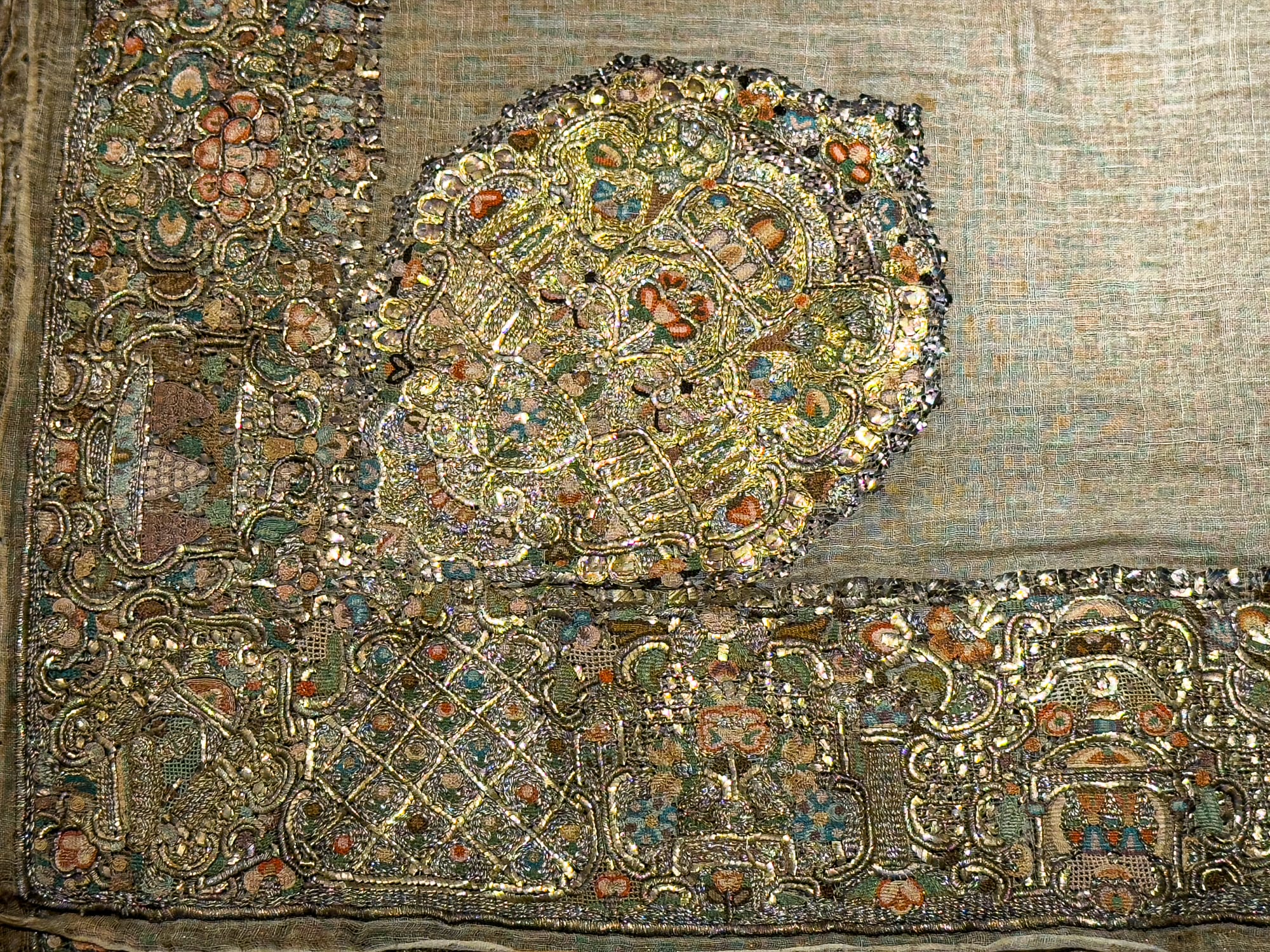
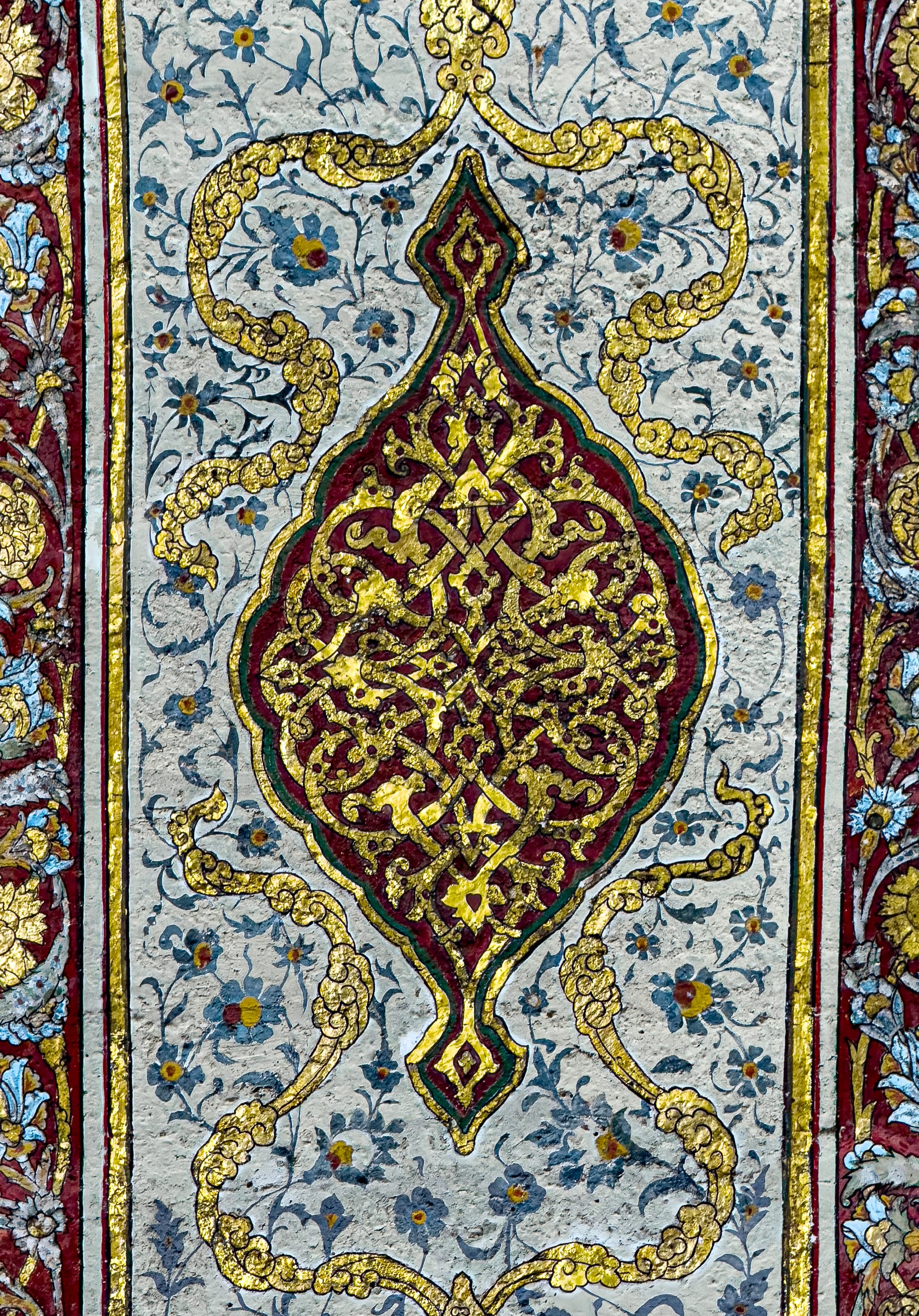
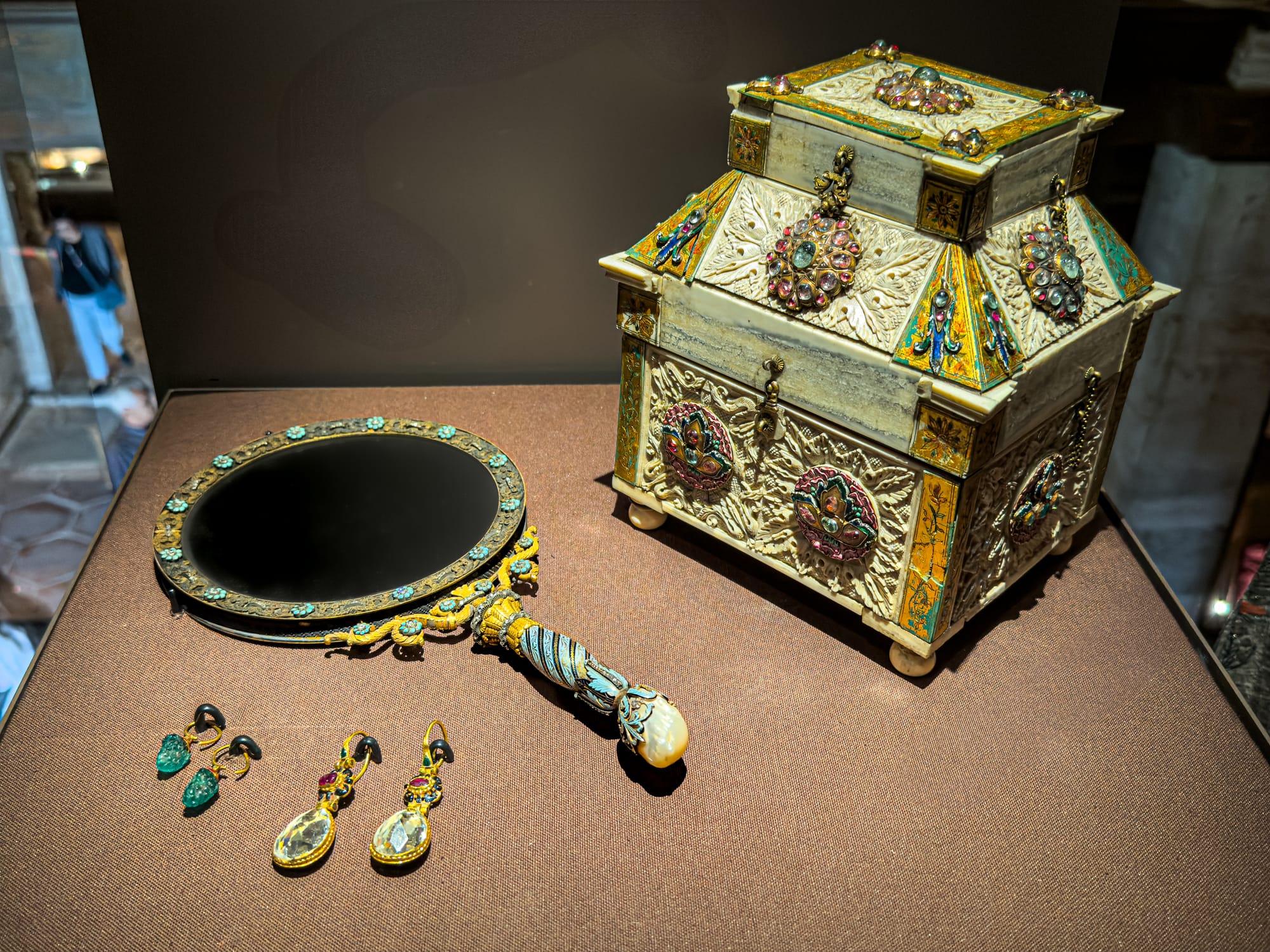
Embroidered textiles, ceremonial garments, and jeweled objects reveal Topkapi’s refined imperial aesthetics
Some of the garments, frozen in glass, look freshly worn: collars folded just so, sleeves spilling gently onto their display plinths. They carry the weight of ceremony, but also trace the human contours of those who lived here.
Domes, ceilings, and architectural details
Topkapi’s domes are an education in Ottoman design. Some feature tight floral tessellations; others are covered in calligraphy rings or radiating gold patterns. These ceilings were often the focal point of a room’s design—pulling the eye upward, suggesting celestial order.
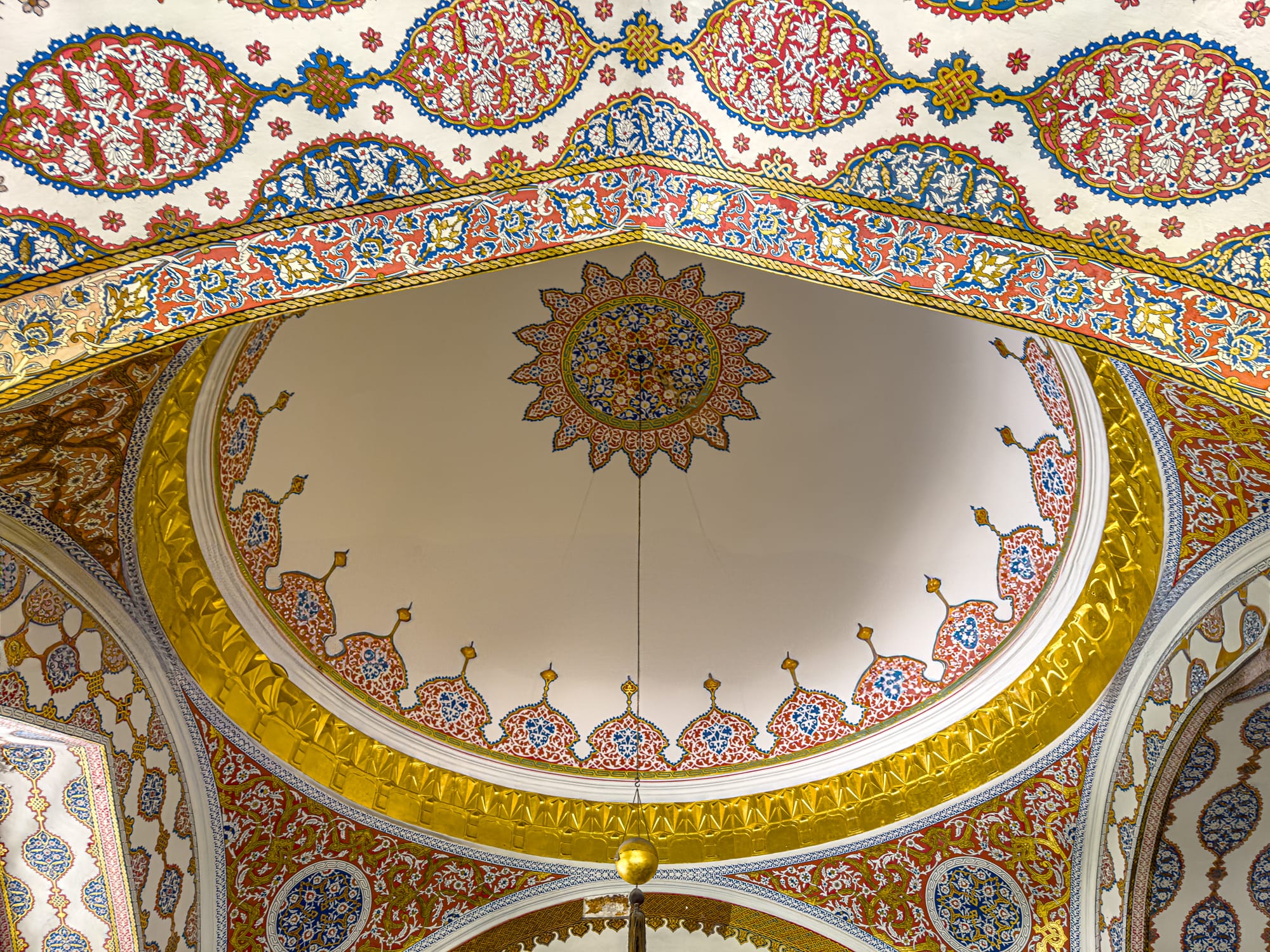
Look up, and you’ll see: light wells, muqarnas (stalactite-like carvings), arabesques flowing across surfaces. The architectural logic of Topkapi was always both aesthetic and symbolic. Domes represented not just the heavens, but sovereignty. Decorative programs reinforced hierarchy and sacred geometry.
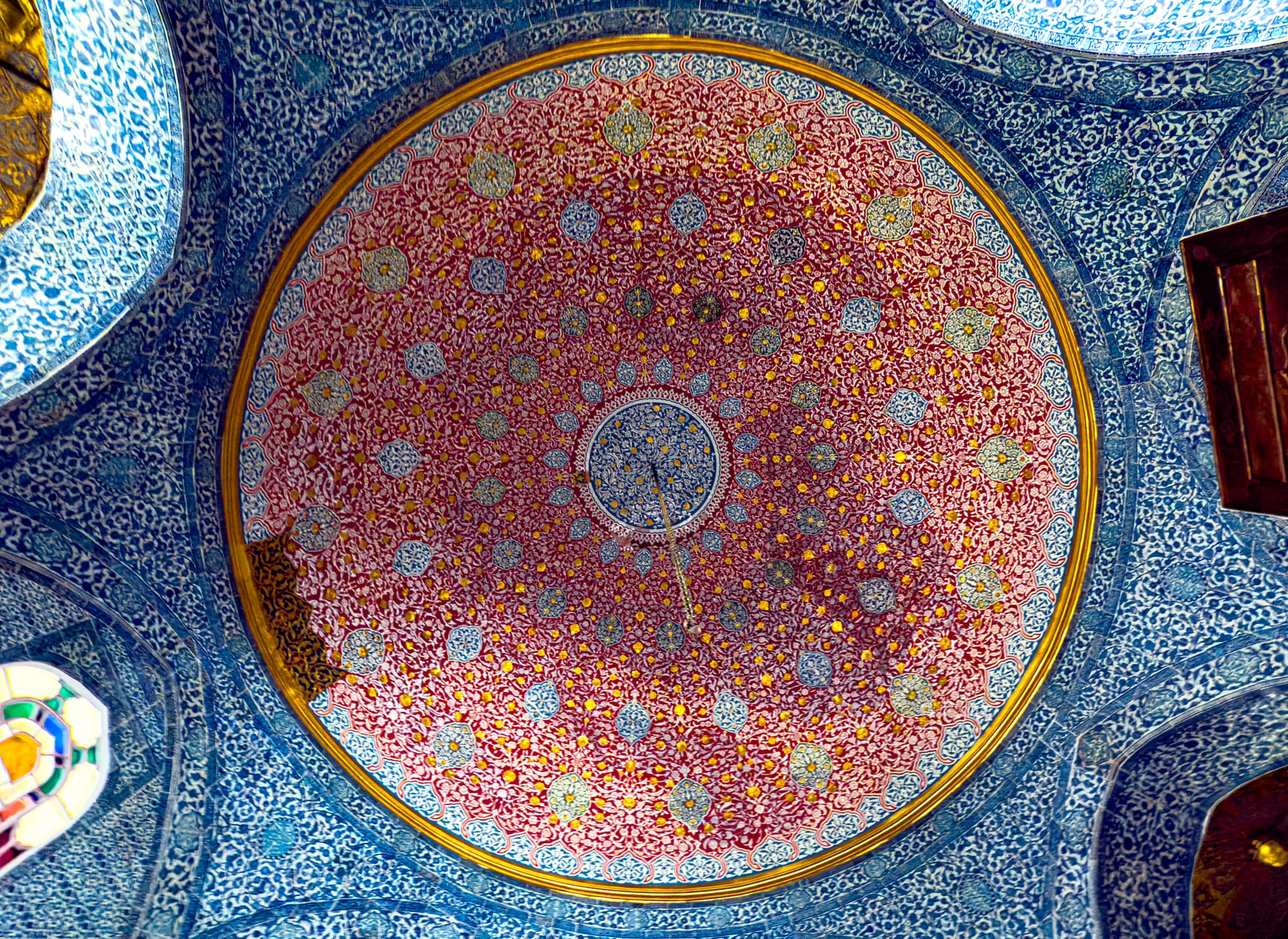
Even transitional spaces—archways, window grilles, fountain niches—are layered with pattern and meaning. Many repeat motifs (tulips, stars, crescents, vine scrolls), subtly tying together very different rooms across the complex.
The gardens and outdoor spaces
Topkapi’s exterior is just as rich as its interiors. Gardens bloom with seasonal color, geometric lawns frame fountains, and quiet tree-lined paths invite rest. The Fourth Courtyard, in particular, feels like a palace within a palace—its marble terraces and pavilions opening onto sweeping Bosphorus views.
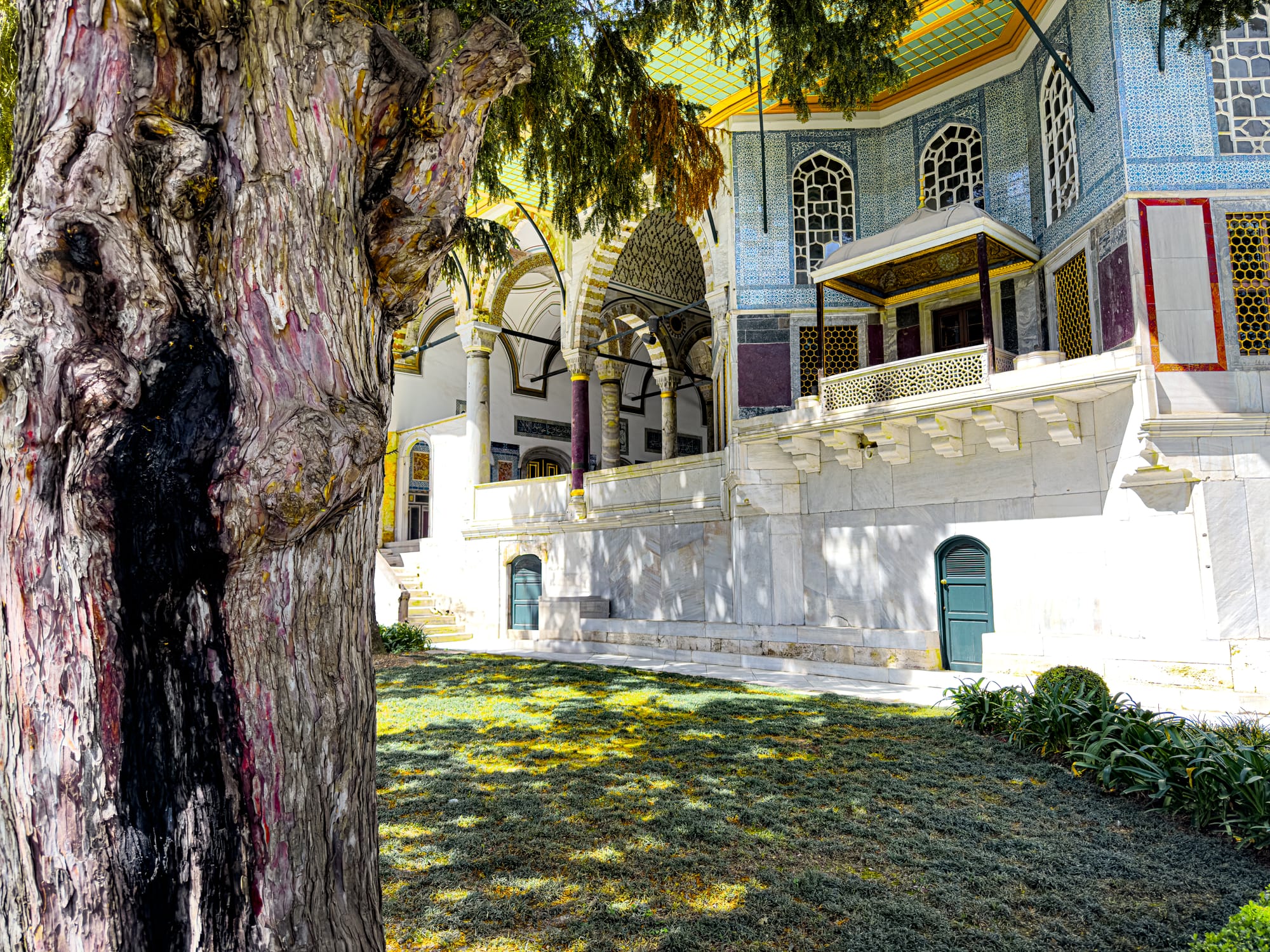
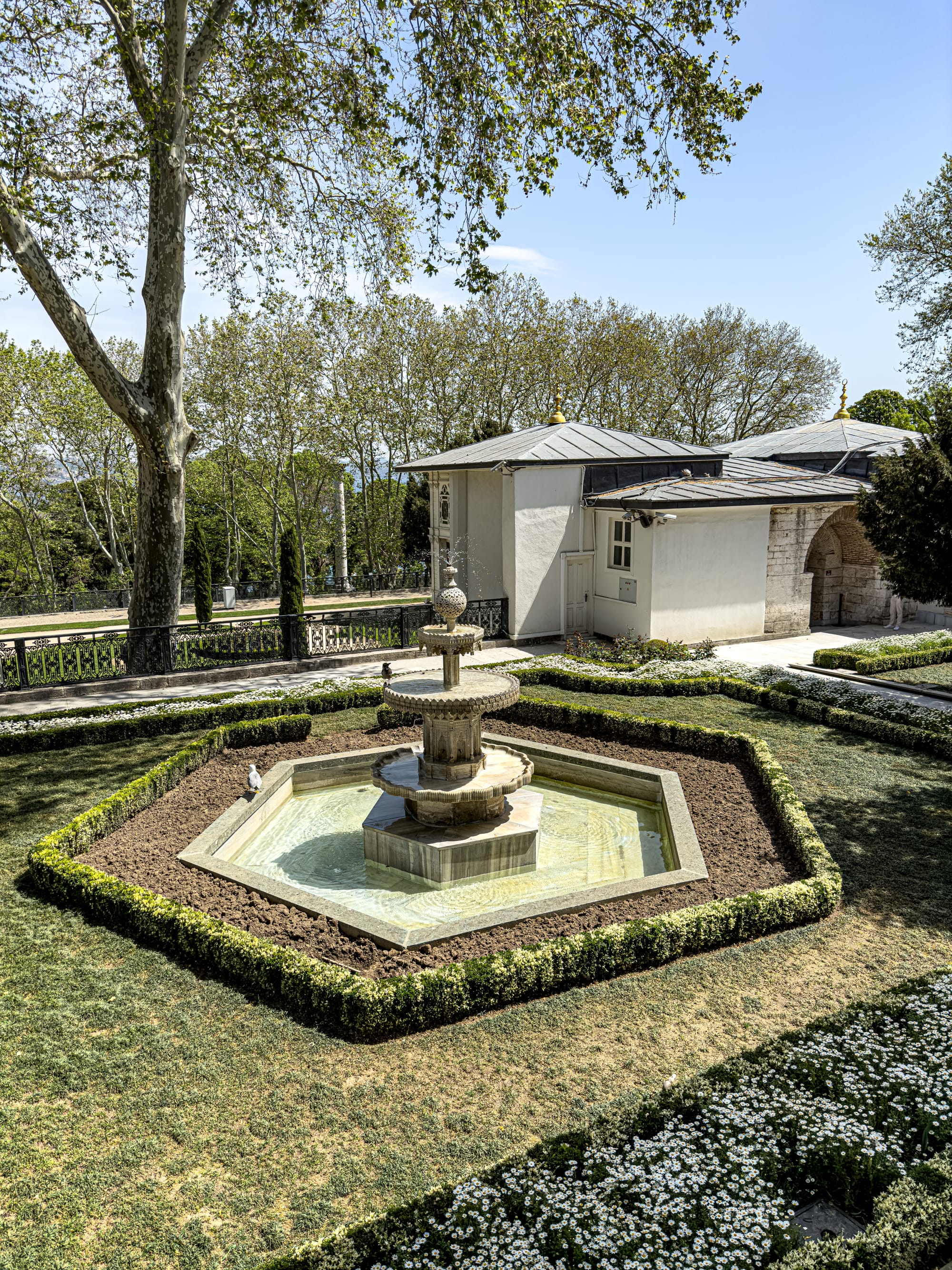
Ancient trees, tiled pavilions, and elegant fountains bring Topkapi’s palace gardens to life
Sultans and their courts often retreated to these areas for rest, poetry, and private ceremony. The tulip garden is an especially iconic part of the grounds, speaking to the Ottoman love of seasonal rhythm, floral symbolism, and cultivated leisure.
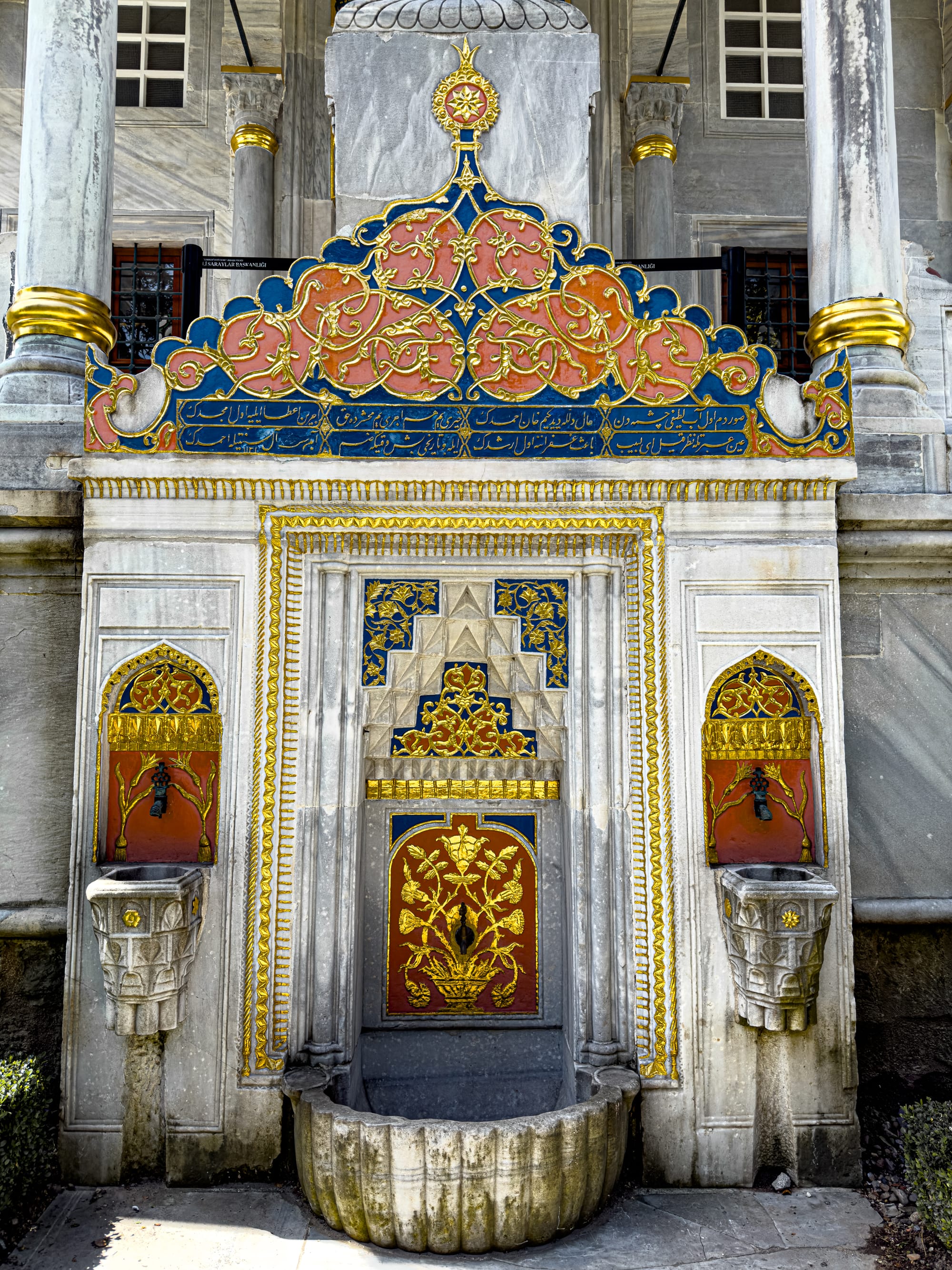
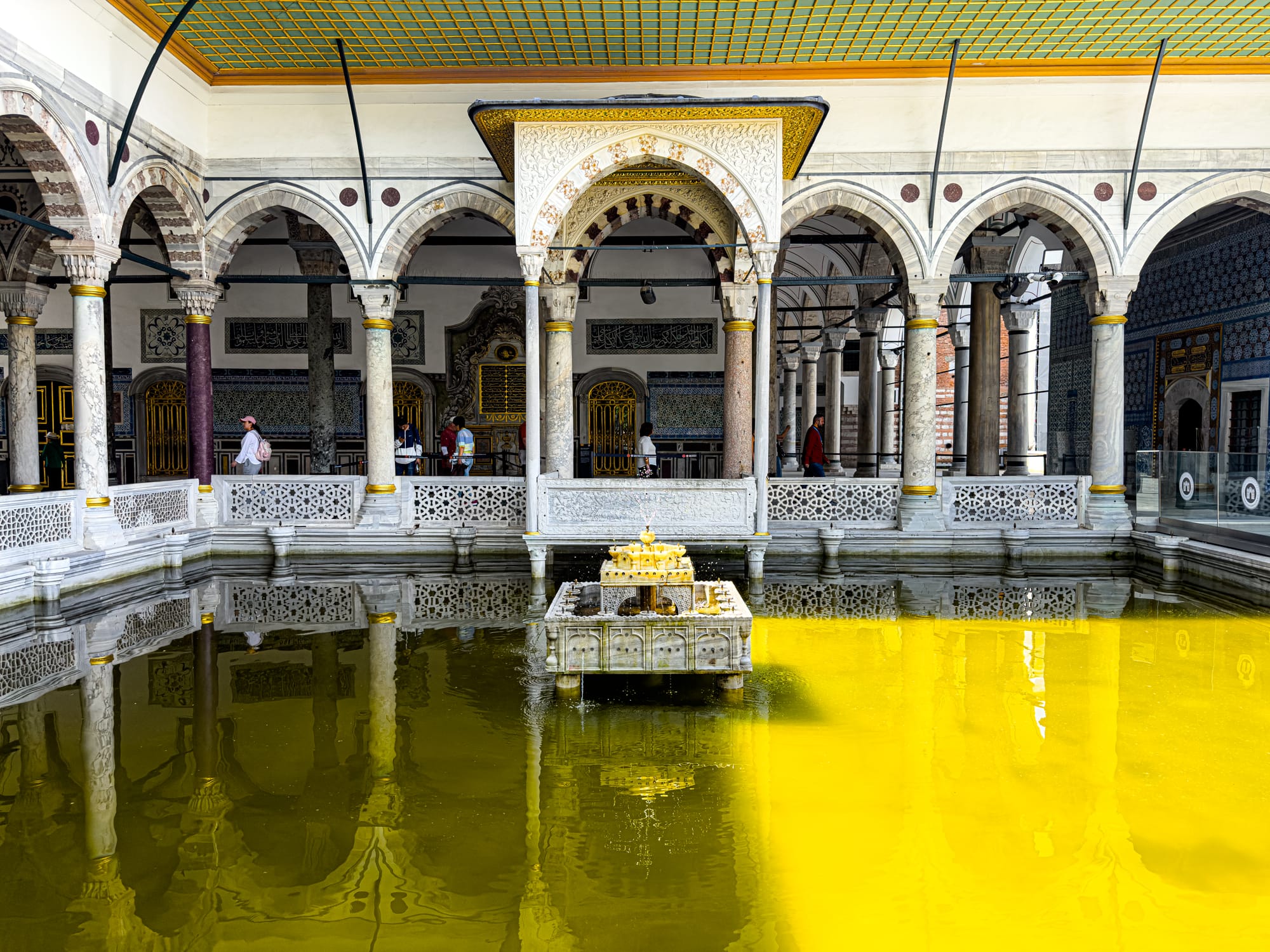
Ottoman fountains and ceremonial pools reflect Topkapi’s love of beauty, geometry, and ritual
You’ll also pass cypress groves, ancient courtyards where political decisions were made, and grassy areas where you can sit and take it all in. For all its spectacle, Topkapi also allows for quiet contemplation.
Tiled rooms and devotional spaces
The tiled rooms at Topkapi are among the most celebrated in the Islamic world. Thousands of hand-painted İznik tiles—many in shades of blue, turquoise, and coral—cover the walls of prayer rooms, audience chambers, and quiet corners.
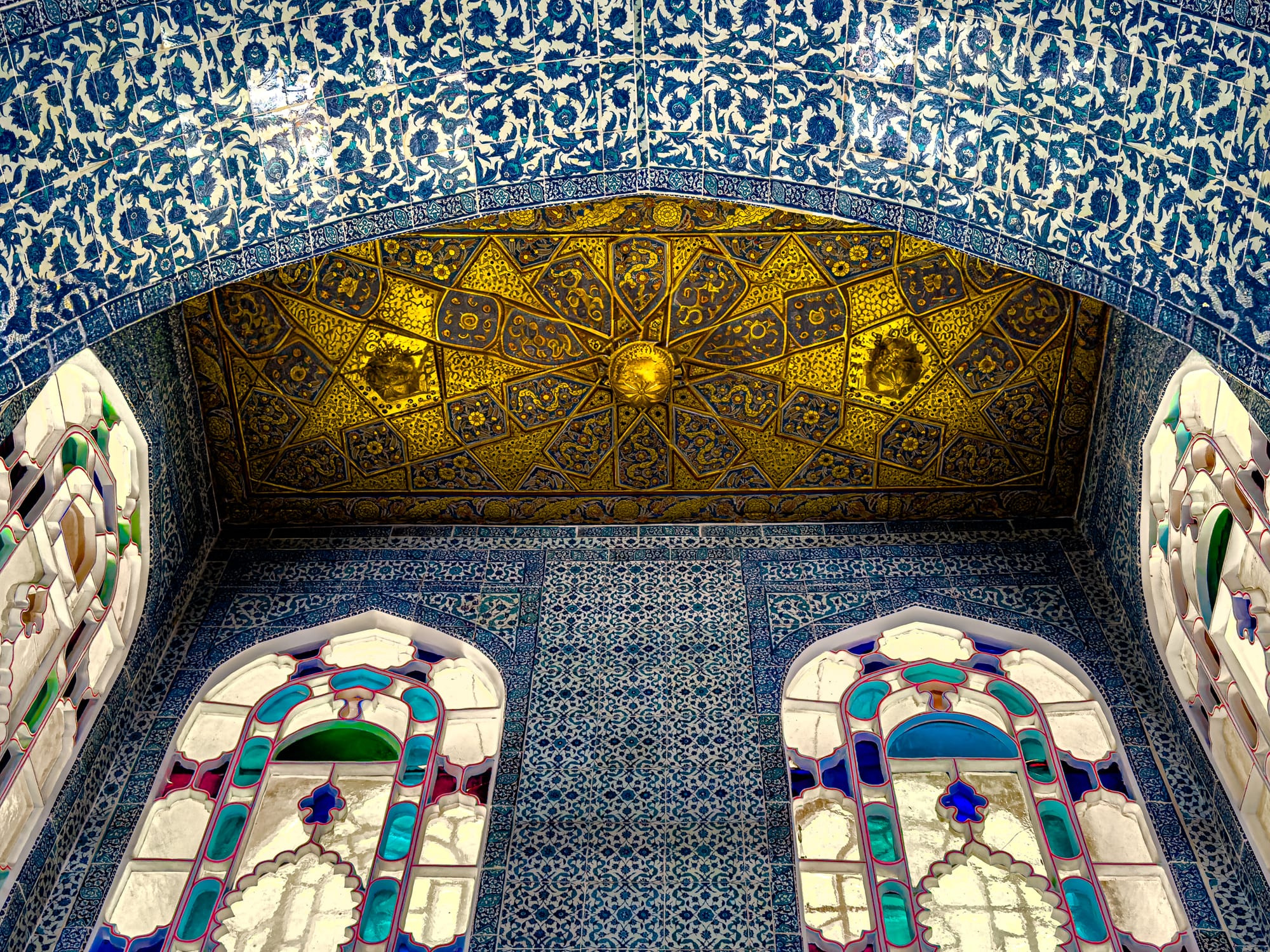
Some tiles are floral, others geometric. Many contain Qur’anic verses or poetic inscriptions. The harmony of pattern and architecture creates an immersive visual field: as if the very walls are humming.
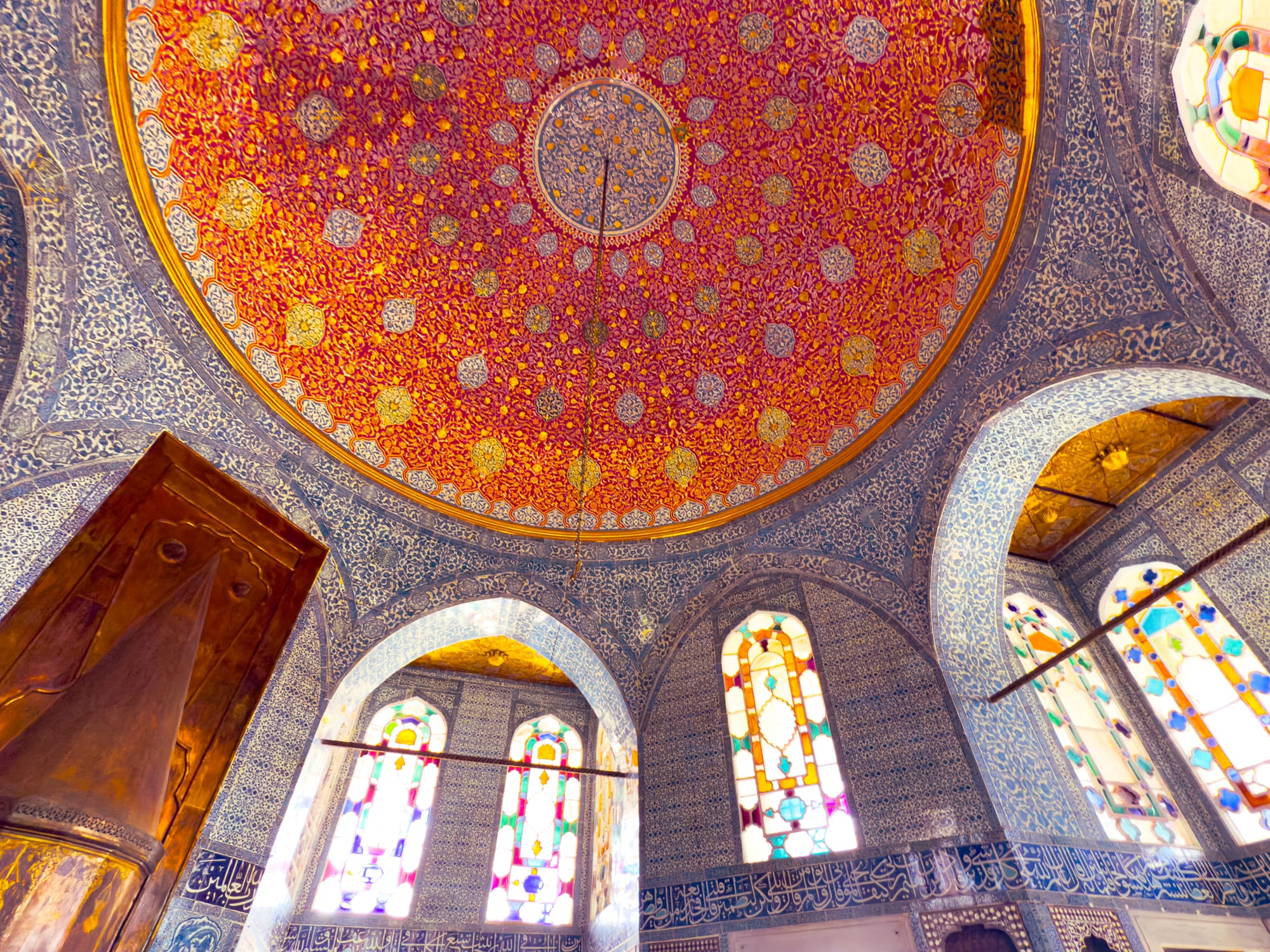
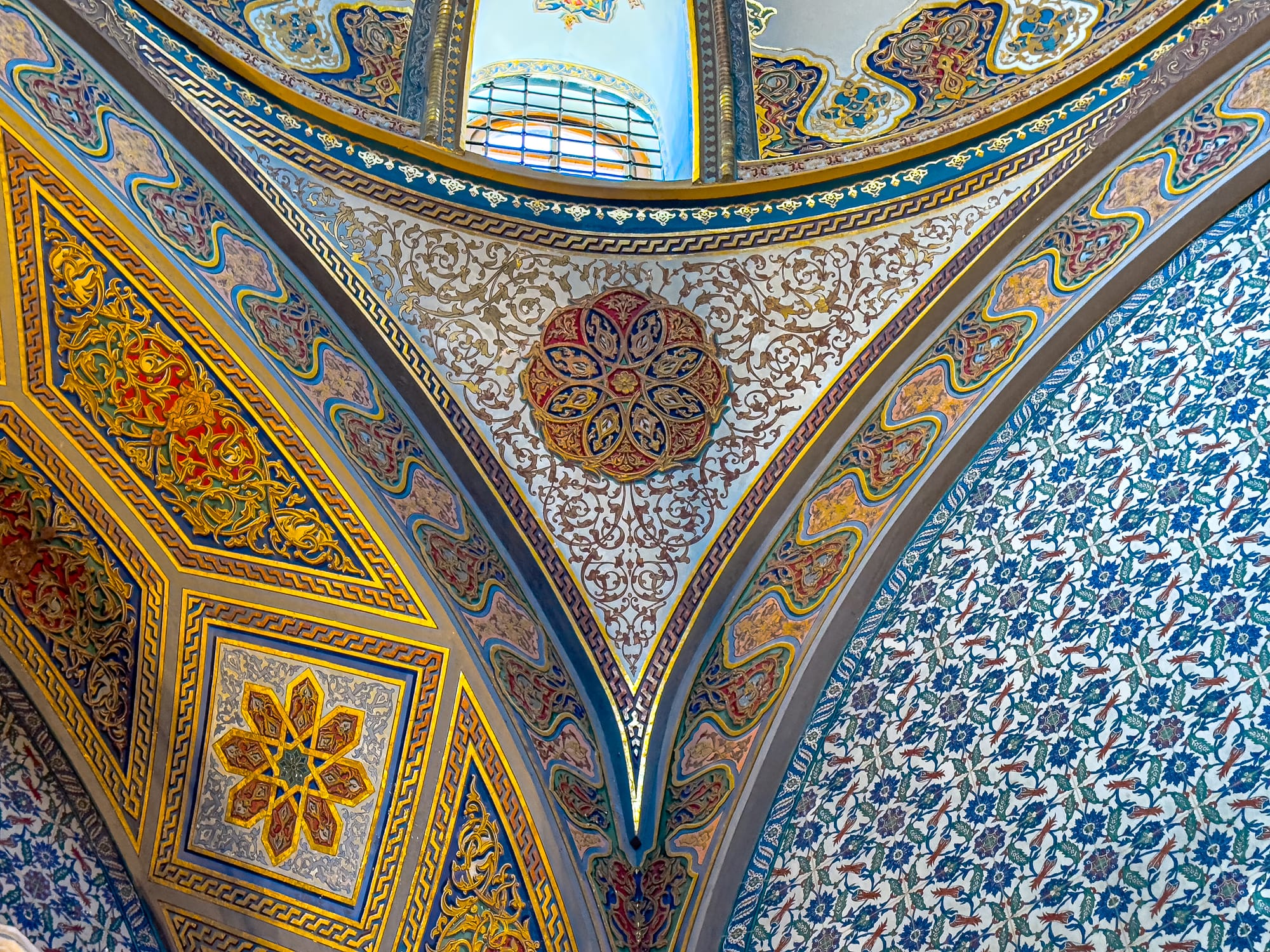
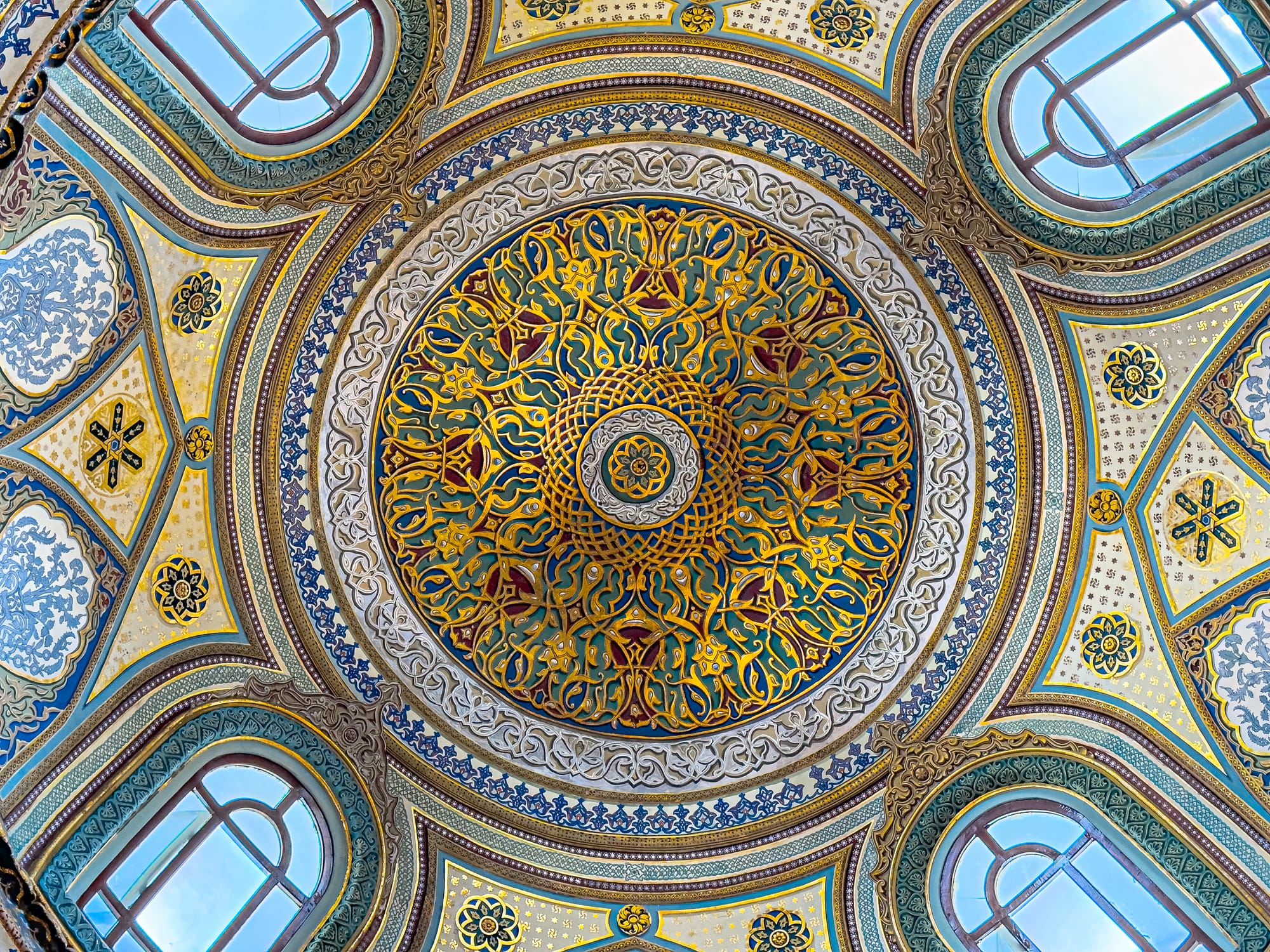
Stained glass windows, kaleidoscopic ceilings, and hand-painted motifs saturate the palace in Ottoman splendor
These spaces were often used for intimate gatherings or reflection. Light slants in through mashrabiya windows. The air is cool. Everything slows down.
A full-day experience
Topkapi isn’t a place to rush. There’s too much to see—and too much that’s invisible until you let your attention soften. A room that felt ornamental at first might, on second glance, reveal a secret door. A robe might hold traces of bloodline and rebellion. A courtyard might hold the memory of exile.
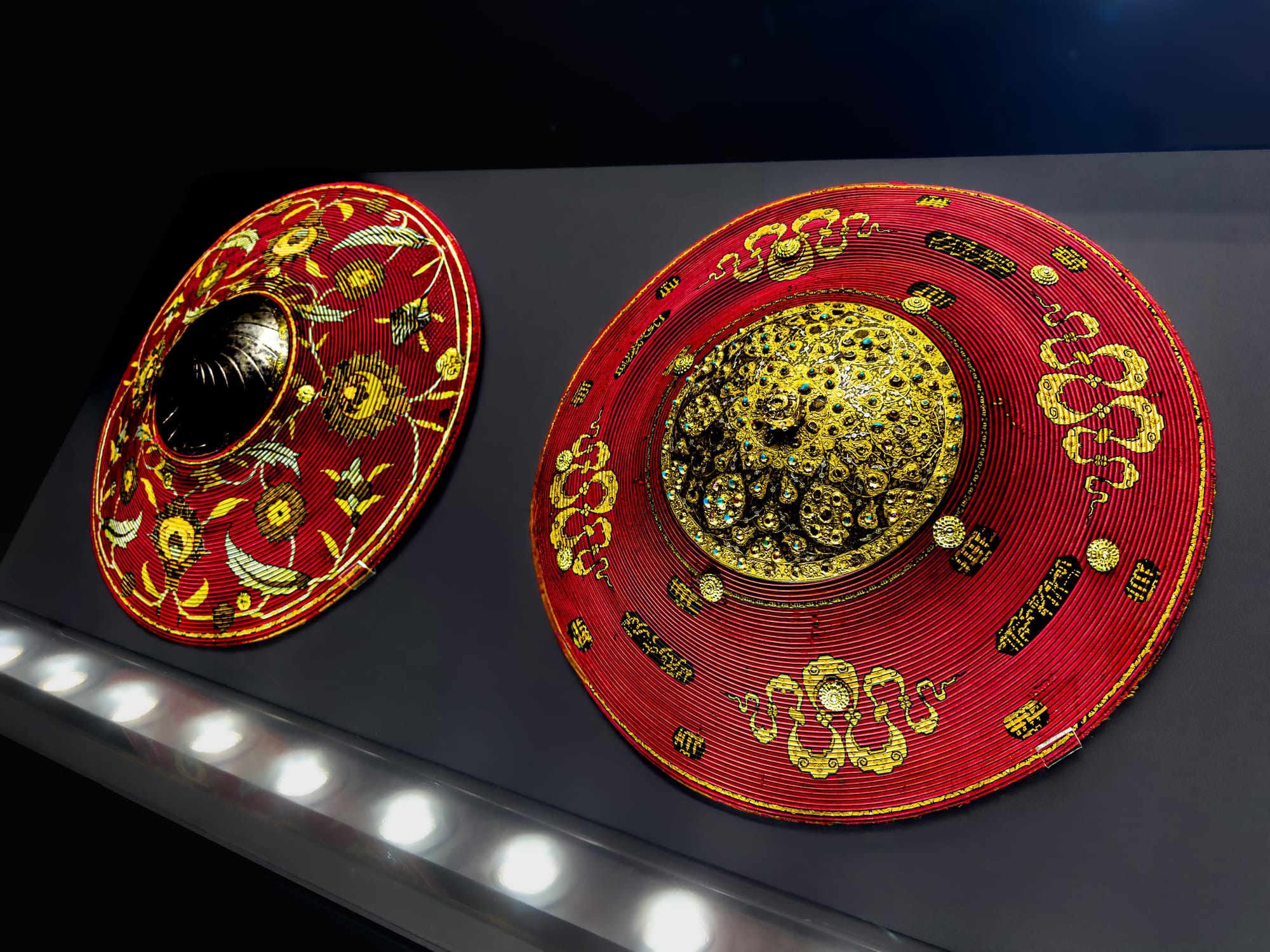
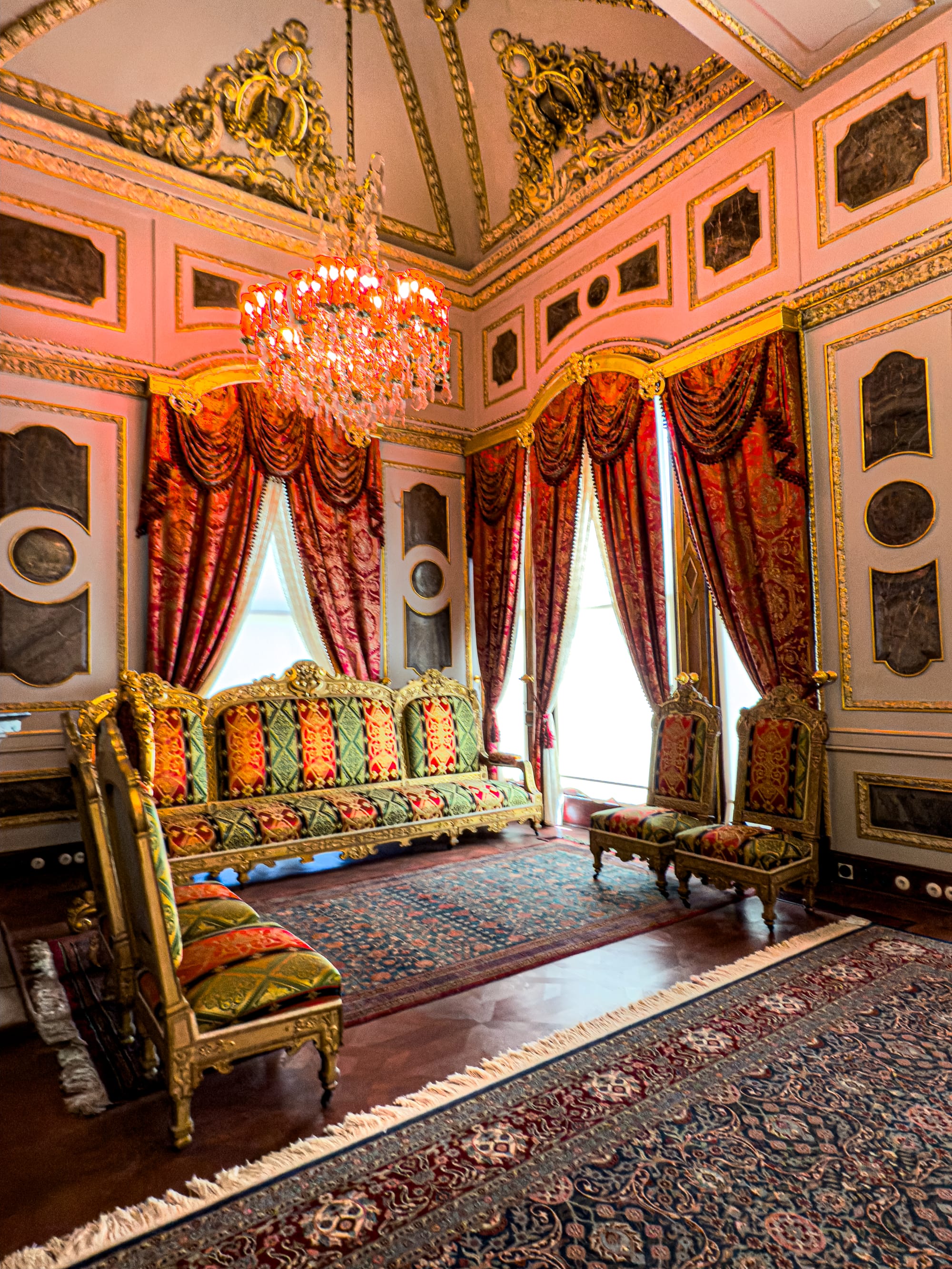
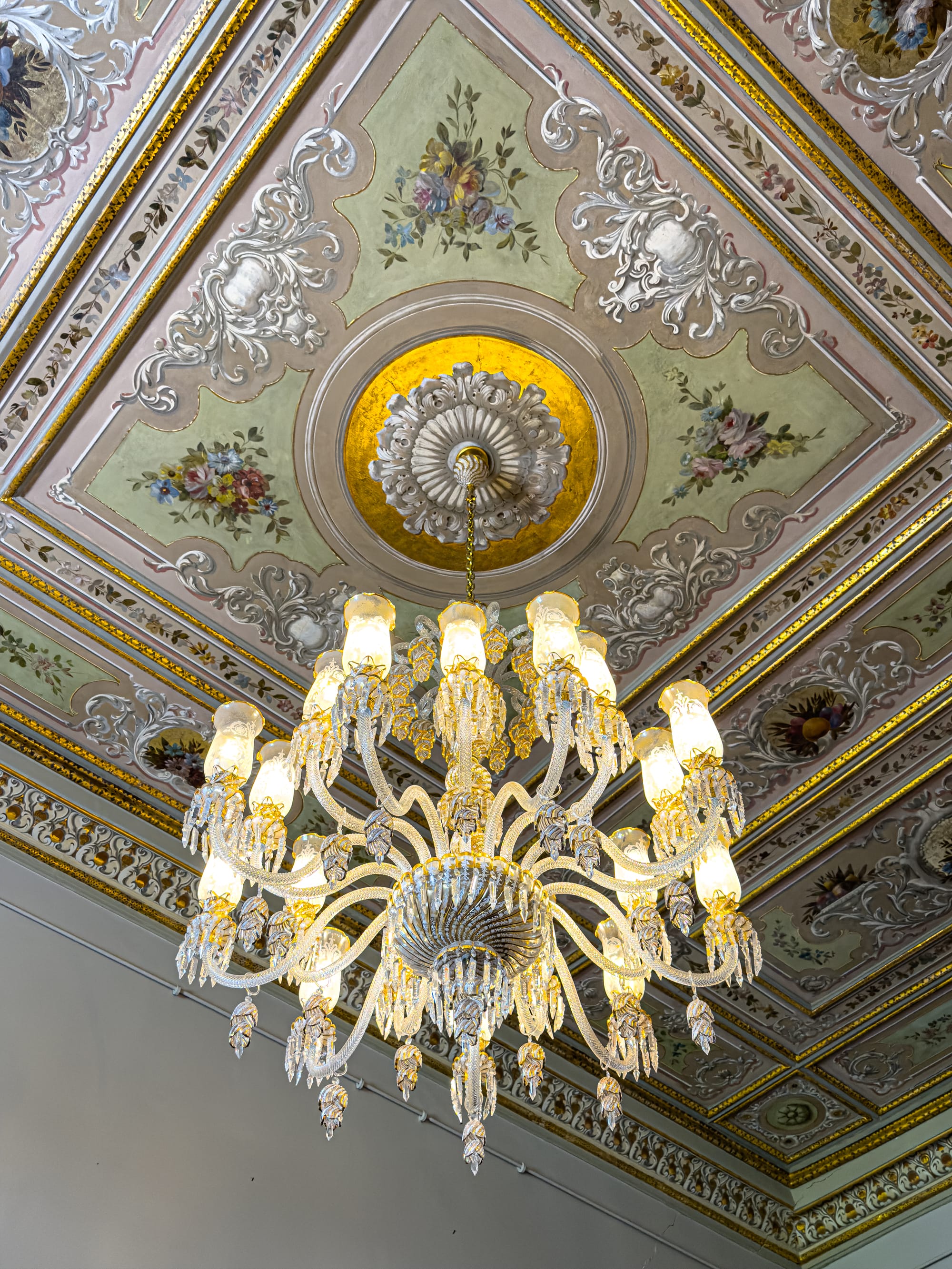
Chandeliers, silk drapery, and painted ceilings capture the opulence of the palace’s private interiors
If you’re planning to visit, we truly recommend treating it as a full-day commitment. Go early. And for ease (and sanity), we recommend getting skip-the-line tickets here. You’ll want to use your energy for exploration—not standing in queues.






